|
By Joe D - 7 Years Ago
|
When engine is up to operating temp (180-195) and while driving around 50-65 mph, engine stalls when trans is placed in neutral. Seems like its starving for gas and not flooding. Does restart with foot to the floor and engine recovers and idles normal after a minute or so. Engine runs great otherwise and this only happens when engine is 180 degrees or higher 195. Vapor Lock in carbs due to ethanol maybe?
Dual Quads (Carter) are off of a 1957 T -Bird I was told.
|
|
By Sandbird - 7 Years Ago
|
|
'57 TBirds came with a pair of Holley carbs and had aluminum spacers sandwiched in between a pair gaskets under each carb used as insulators. The Holley carbs were special for the dual carb setup. Might be a heat problem if you don't have the insulators and/or your Carters may be a mismatch.
|
|
By KULTULZ - 7 Years Ago
|
"Vapor Lock in carbs due to ethanol maybe?"
When it does this, pull over and check for accelerator pump shot and/or spark.
|
|
By Joe D - 7 Years Ago
|
How would I check the accelerator pump? It does restart so I assume the ignition is ok.
|
|
By KULTULZ - 7 Years Ago
|
"How would I check the accelerator pump? It does restart so I assume the ignition is ok"
No.1 - Never a$$-u-me anything. I thought marriage would be a good idea and got tricked on that one.
To check the fuel, remove the ACL and operate the throttle linkage while looking for a fuel shot down the throat of the carb. If no shot, most likely an empty fuel bowl due to heat soak/boiling of fuel. You may also have bad ignition parts (condenser) that shuts the car down with heat.
If no fuel, you will have to isolate the carbs with phenolic carb spacers and maybe insulate the fuel line from pump to carb.
Also verify pump pressure/volume delivery and any possible air leaks in the fuel line from tank to pump.
It's usually ethanol blended fuel as at temp it experiences blend separation and is more prone to evaporation due to a lower boiling point.
|
|
By Joe D - 7 Years Ago
|
OK I'll check next time it stalls to see if fuel bowl is dry.
I have Pertronix electronic points. do you think they could be the cause?
|
|
By Joe D - 7 Years Ago
|
I forgot to mention that I did try insulating the fuel lines all the way to the carbs and I installed a high flow cartridge type fuel filter back by the fuel tank.
It does look like there are spacers under the carbs that are about 1/2" thick.
Thanks for all your help
|
|
By Joe D - 7 Years Ago
|
|
|
|
By KULTULZ - 7 Years Ago
|
PERTRONIX-
IGNITOR I has given problems
IGNITOR II is a better option.
Check both IGN and FUEL to CYA.
Here is a film showing fuel percolation-
https://www.youtube.com/watch?v=cadNfSNi_Oc
The spacers you see are most likely OEM aluminum, and will conduct engine heat to the carb fuel bowls. You need phenolic (plastic) spacers to cut down on the heat transfer.
Remember, this may also be vapor lock and/or blend separation on the suction side of the pump (tank to pump) also. If the rubber fuel lines are not ethanol rated, they can break down inside and cause a flow restriction too. Just a reminder.
|
|
By Lord Gaga - 7 Years Ago
|
Is there a 'sock' filter on the fuel pickup in your gas tank? Have you checked the fuel pump pressure and volume?
|
|
By Joe D - 7 Years Ago
|
|
There is not a sock filter. just a pick up tube. I installed a new aluminum 17 gal tank under where the spare tire went. Also all new SS braided fuel lines, Summit cartridge type high flow fuel filter near tank (suction side of pump), and a new Edelbrock fuel pump (6 psi).
|
|
By Joe D - 7 Years Ago
|
Thanks Kultulz, I'm going to try get a tank of aviation gasoline (no ethanol) from a local landscape equipment company.
Going to check spacers. I don't think they are aluminum though. I'll let you know.
This was really helpful!
Joe D
|
|
By Joe D - 7 Years Ago
|
I checked and the spacers are aluminum and the gaskets are steel. Do they sell stock material that you can cut yourself. Should I make these as thick as possible to fit under hood? Maybe 1, 2, or 3". I do have room.
Thanks
|
|
By charliemccraney - 7 Years Ago
|
|
Steel gaskets? You sure?
|
|
By Joe D - 7 Years Ago
|
It seems that way since a magnet would not stick to aluminum spacer but did stick to side of top and bottom gaskets.
Thanks a cool truck by the way!
|
|
By KULTULZ - 7 Years Ago
|
Try this for gasoline-
https://www.pure-gas.org/
|
|
By KULTULZ - 7 Years Ago
|
"Steel gaskets? You sure?"
It must be those combination fiber/steel mesh like gaskets.
|
|
By KULTULZ - 7 Years Ago
|
"Do they sell stock material that you can cut yourself. Should I make these as thick as possible to fit under hood? Maybe 1, 2, or 3". I do have room."
Yes, they sell sheet stock if you want to make your own. Usually, you want just 1/4" as raising the spacer height may play with plenum volume.
Here is a set of store bought - https://www.dashman.net/product.html?id=207
Just isolate the problem before throwing money at it. I don't want you to get mad at me.
Did you say you have an inline filter before the mechanical pump? What micron size?
What is the application, a pickup with a "292"?
|
|
By Lou - 7 Years Ago
|
|
Your problem sounds like a vaccuum leak, not a fuel problem.
|
|
By kevink1955 - 7 Years Ago
|
Did anyone pick this up from the first post
"Does restart with foot to the floor and engine recovers and idles normal after a minute or so"
It's not starving for fuel, it's flooding most likely from fuel boiling in the bowls. insulated carb spacers may help.
|
|
By Joe D - 7 Years Ago
|
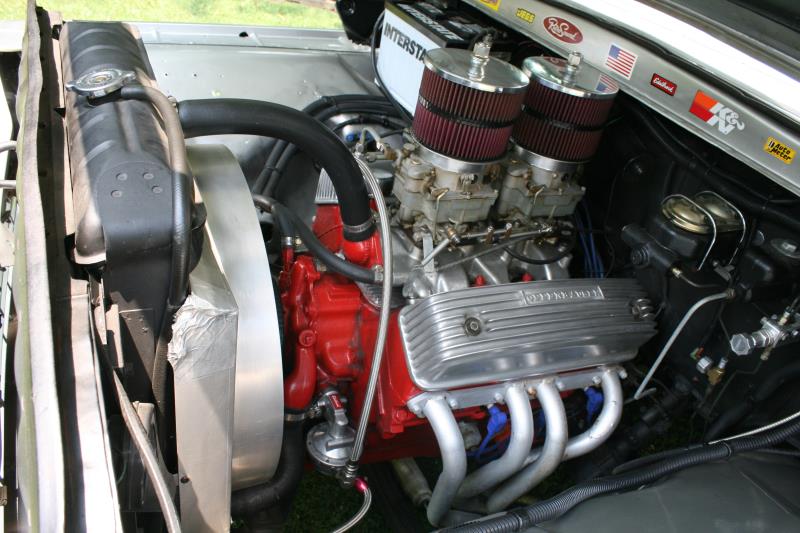
The cartridge type filter is 10 micron and is installed back by the fuel tank (pump suction). I recently installed this and removed a small inline filter right before the pump suction. I had heard so much about fuel boiling and pump cavitation.
The dual quads are on a 292 Y block in a 1960 F-100 (The Frig), with 3 on the tree.
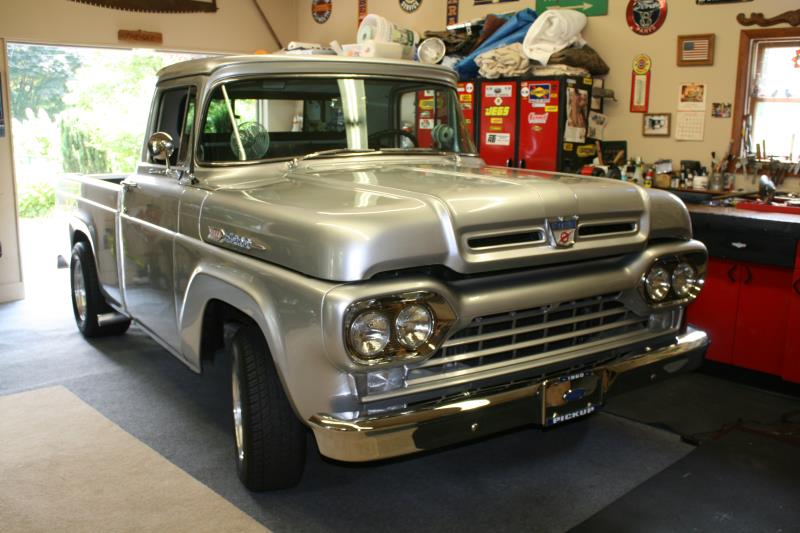
|
|
By Joe D - 7 Years Ago
|
Kevin,
I thought if the fuel is boiling inside the carb bowls it would be lean or starving for fuel.
Next time it stalls I'm going to pull off the road and look inside the carb throat and pull back on throttle cable and see if gas squirts out. If it does I'm probably flooding. If it doesn't I would think it's boiling off and causing vapor lock in carb bowl.
Thanks,
Joe
|
|
By kevink1955 - 7 Years Ago
|
Usually when fuel boils off in the bowl it is pushed out the vents in the air horn and drowns the engine with fuel.
When you get it restarted can you smell fuel or does it smoke from the exhaust until it clears the excess fuel and smooths out ?
|
|
By KULTULZ - 7 Years Ago
|
That is a sharp looking pickup and engine detail.
You have a braided fuel supply hose running awfully close to the upper radiator hose/ heater outlet. That may be the source of heat ingestion. How high does the coolant temp go when this happens?
The phenolic spacer(s) also isolate engine heat so as to keep the fuel cooler so as to provide a denser fuel mixture.
Also was suggested a possible vacuum leak. Do you have a fuel pressure/vacuum test gauge?
|
|
By KULTULZ - 7 Years Ago
|
Hey Joe D,
Any chance of seeing the engine right side? I would like to see how you plumbed fuel delivery. Do you have a filter on the pressure side?
|
|
By Joe D - 7 Years Ago
|
Thanks for the help Men!
I never have smelled gas like its flooding and no smoke or back firing when restarting.
Coolant temperature around 180 degrees and confirmed with a digital heat gun. I also tried insulating pressure side lines up to the carbs and still stalled. I do think its an inside carb issue.
I do not have a vacuum gage but my neighbor does! What would be the test with this?
I'll get a right side photo that shows hard piping going to carbs. I removed the brass screens on the catb inlets but this did not help either. Thanks again!
|
|
By Joe D - 7 Years Ago
|
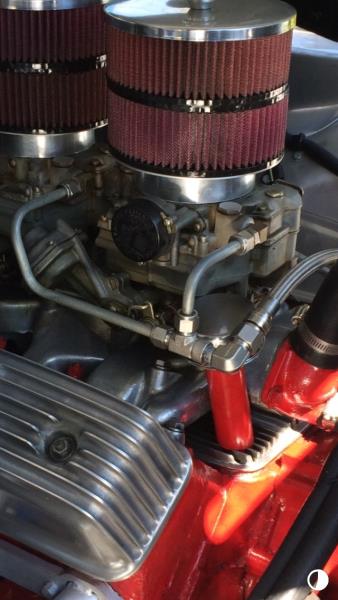
|
|
By Joe D - 7 Years Ago
|
Having trouble ID ing these Carter 4 barrel carbs. No tags and markings around base that I can find.
|
|
By KULTULZ - 7 Years Ago
|
"Having trouble ID ing these Carter 4 barrel carbs. No tags and markings around base that I can find"
Without the ASSEMBLY ID TAG(S), identification is going to be difficult as kits, parts and specs will vary between car makes.
.http://www.secondchancegarage.com/public/186.cfm
I'll attach an interpretation chart a little later.
https://www.onallcylinders.com/wp-content/uploads/2016/03/31/vacumm-reading-1-752x1024.png
By any chance, can you see any CASTING ID NOS. on the actual intake manifold?
"Coolant temperature around 180 degrees and confirmed with a digital heat gun. I also tried insulating pressure side lines up to the carbs and still stalled. I do think its an inside carb issue."
Don't forget ethanol blended gasoline has a much lower boiling point. Shoot the thermometer at that braided fuel line after driving for a while. It is sitting in direct airflow from a hot radiator. Also try to get an engine compartment temp reading. Usually, fuel bowl percolation happens after shutdown and resultant engine heat soak, causing the fuel to boil out of the bowl vents. Much heat is also picked up @ the mechanical fuel pump as it is attached to the engine directly.
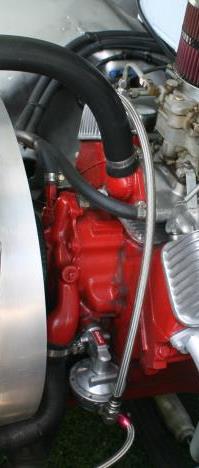
You do have a filter before the carbs?
Wish I would get my act together ...
The reason for the vacuum gauge is to insure the engine is tight. Some leaks manifest themselves once the engine is hot and things begin to expand.
|
|
By miker - 7 Years Ago
|
I’m not sure either of these will apply to you, but it’s my experience and involved stalling engines.
I had a fine Moroso fuel filter installed at the rear before the electric pump. New fuel tank, but I got a bad tank of gas. It would plug up while driving, then restart a minute later. I limped home and pulled it, it was full of very fine particles. I replaced it with an oem style filter and solved the problem. I was told the fine filter should have a coarser filter in front on the suction side, and then be pressurized. And the racers clean them between every run. You mentioned you just installed one.
I had a very similar hot/driving problem to yours on a car I move to a new location. Hot day, from sea level to 2600 ft., it loaded up and died. I thought to was vapor lock, but it restarted at full throttle. The local speed shop guys said “it’s the attitude change and the pressure regulator. Either put a gauge on it and reset the pressure, or try lowering the float level just a bit”. Since it was a Holley, I pulled the sight plugs and took it down I/2 turn on the external adjustment. Problem solved. When I can get it on a hoist and get to the regulator I’ll do it right. But this is a boost referenced blow thru supercharged motor. So it could be the increase in temp is affecting the pressure and that’s where the flooding is coming from. I don’t know.
|
|
By miker - 7 Years Ago
|
I’m not sure either of these will apply to you, but it’s my experience and involved stalling engines.
I had a fine Moroso fuel filter installed at the rear before the electric pump. New fuel tank, but I got a bad tank of gas. It would plug up while driving, then restart a minute later. I limped home and pulled it, it was full of very fine particles. I replaced it with an oem style filter and solved the problem. I was told the fine filter should have a coarser filter in front on the suction side, and then be pressurized. And the racers clean them between every run. You mentioned you just installed one.
I had a very similar hot/driving problem to yours on a car I move to a new location. Hot day, from sea level to 2600 ft., it loaded up and died. I thought to was vapor lock, but it restarted at full throttle. The local speed shop guys said “it’s the attitude change and the pressure regulator. Either put a gauge on it and reset the pressure, or try lowering the float level just a bit”. Since it was a Holley, I pulled the sight plugs and took it down I/2 turn on the external adjustment. Problem solved. When I can get it on a hoist and get to the regulator I’ll do it right. But this is a boost referenced blow thru supercharged motor. So it could be the increase in temp is affecting the pressure and that’s where the flooding is coming from. I don’t know.
|
|
By Joe D - 7 Years Ago
|
KULTULZ (10/26/2018)
"Having trouble ID ing these Carter 4 barrel carbs. No tags and markings around base that I can find" Without the ASSEMBLY ID TAG(S), identification is going to be difficult as kits, parts and specs will vary between car makes. . http://www.secondchancegarage.com/public/186.cfmI'll attach an interpretation chart a little later. https://www.onallcylinders.com/wp-content/uploads/2016/03/31/vacumm-reading-1-752x1024.pngBy any chance, can you see any CASTING ID NOS. on the actual intake manifold? "Coolant temperature around 180 degrees and confirmed with a digital heat gun. I also tried insulating pressure side lines up to the carbs and still stalled. I do think its an inside carb issue." Don't forget ethanol blended gasoline has a much lower boiling point. Shoot the thermometer at that braided fuel line after driving for a while. It is sitting in direct airflow from a hot radiator. Also try to get an engine compartment temp reading. Usually, fuel bowl percolation happens after shutdown and resultant engine heat soak, causing the fuel to boil out of the bowl vents. Much heat is also picked up @ the mechanical fuel pump as it is attached to the engine directly.  You do have a filter before the carbs? No, I removed the fine brass screens that were in the carb inlet ports. It didn't help but I left them out for now. Wish I would get my act together ... The reason for the vacuum gauge is to insure the engine is tight. Some leaks manifest themselves once the engine is hot and things begin to expand.
|
|
By Joe D - 7 Years Ago
|
KULTULZ (10/26/2018)
"Having trouble ID ing these Carter 4 barrel carbs. No tags and markings around base that I can find" Without the ASSEMBLY ID TAG(S), identification is going to be difficult as kits, parts and specs will vary between car makes. . http://www.secondchancegarage.com/public/186.cfmI'll attach an interpretation chart a little later. https://www.onallcylinders.com/wp-content/uploads/2016/03/31/vacumm-reading-1-752x1024.pngBy any chance, can you see any CASTING ID NOS. on the actual intake manifold? "Coolant temperature around 180 degrees and confirmed with a digital heat gun. I also tried insulating pressure side lines up to the carbs and still stalled. I do think its an inside carb issue." Don't forget ethanol blended gasoline has a much lower boiling point. Shoot the thermometer at that braided fuel line after driving for a while. It is sitting in direct airflow from a hot radiator. Also try to get an engine compartment temp reading. Usually, fuel bowl percolation happens after shutdown and resultant engine heat soak, causing the fuel to boil out of the bowl vents. Much heat is also picked up @ the mechanical fuel pump as it is attached to the engine directly.  You do have a filter before the carbs? Wish I would get my act together ... The reason for the vacuum gauge is to insure the engine is tight. Some leaks manifest themselves once the engine is hot and things begin to expand. I removed the fine brass screens that were in the carb inlet ports.
|
|
By Joe D - 7 Years Ago
|
I removed the fine brass screens that were in the carb ports.
KULTULZ (10/26/2018)
"Having trouble ID ing these Carter 4 barrel carbs. No tags and markings around base that I can find" Without the ASSEMBLY ID TAG(S), identification is going to be difficult as kits, parts and specs will vary between car makes. . http://www.secondchancegarage.com/public/186.cfmI'll attach an interpretation chart a little later. https://www.onallcylinders.com/wp-content/uploads/2016/03/31/vacumm-reading-1-752x1024.pngBy any chance, can you see any CASTING ID NOS. on the actual intake manifold? "Coolant temperature around 180 degrees and confirmed with a digital heat gun. I also tried insulating pressure side lines up to the carbs and still stalled. I do think its an inside carb issue." Don't forget ethanol blended gasoline has a much lower boiling point. Shoot the thermometer at that braided fuel line after driving for a while. It is sitting in direct airflow from a hot radiator. Also try to get an engine compartment temp reading. Usually, fuel bowl percolation happens after shutdown and resultant engine heat soak, causing the fuel to boil out of the bowl vents. Much heat is also picked up @ the mechanical fuel pump as it is attached to the engine directly.  You do have a filter before the carbs? Wish I would get my act together ... The reason for the vacuum gauge is to insure the engine is tight. Some leaks manifest themselves once the engine is hot and things begin to expand.
|
|
By Joe D - 7 Years Ago
|
Ok tonight I drove the truck and it took awhile to make it stall because it was cool outside (52 degrees). After getting it to stall I pulled off the side of the road and checked the carbs:
I look into the carbs and saw some cloudy vapors. When I pulled back on the throttle gas did squirt in the back carb and then the front carb. I also checked the exhaust and it didn't smell like gas.
I'm going to get a tank full of ethanol free gas and see what happens. Stay tuned!
Thanks for all the help,
Joe D
|
|
By KULTULZ - 7 Years Ago
|
At the minimum, reinstall those screens. You have no particulate protection as the 10 micron inline filter @ the tank acts as a sock filter (as on later applications) and only catches boulders and JAP midget submarines (but it is useful).
When it shut down, did you check for spark also? The condensers coming through now are junk. Once they cool a little, the engine will fire right up.
Also on a possible vacuum leak. When this occurs it will lean out the fuel mixture at that point.
|
|
By Joe D - 7 Years Ago
|
I did not check spark but it always starts back up. I will pull a plug sometime to see if it is wet. Delaying that maneuver since they are hard to get at and those headers are hot!
Ok I will reinstall the fine mesh screens.
I don't have a condenser. I have PerTronix electronic points remember?
Hunting down these ethanol free gas stations. Hopefully it will stop raining someday in Pa!
Thanks again!!
|
|
By Joe D - 7 Years Ago
|
Oh, I also checked for vacuum leaks around carbs by spraying carbs while running with carb cleaner and found nothing yet.
|
|
By KULTULZ - 7 Years Ago
|
"I don't have a condenser. I have PerTronix electronic points remember?"
And I am an old fart that has advanced CRS. Please remember that... 
Do you know if you have the IGNITOR I or II?
If you cannot determine a vacuum leak at the actual occurrence timing, you will most likely have an internal carb(s) problem.
Say your intake is not torqued down properly, it may induce a vacuum leak at a certain temp as it is allowed to move. Just something to think about. You need to buy (IMO) a combination vacuum/fuel pressure gauge ($20) just to verify engine condition and tune.
Did you kit the carbs at install or were they ready to go?
|
|
By GREENBIRD56 - 7 Years Ago
|
|
Just opened this to check on progress ...... there is an ancient thread that explains an old problem with the Pertronics being grounded properly. The factory braided copper jumper from the point plate to the dizzy housing must remain effective - and the dizzy must ground effectively to the block. Otherwise the voltage to the little black box doesn't stay at the appointed level. Probably not the case here...
What idle speed are you maintaining with this outfit? Will raising it impact the problem? My bird will go clear down to 450 without too much trouble (factory cam and Demon carb) - but not a good idea with the auto trans in drive. Sounds like your idle drops too low when the temp is up at operating temperature.
Fuel pump may need to be thumping along a little quicker to draw sufficient suction. On my outfit I chose to put a pressurized canister style filter on the carb side - not the tank line.
How do you have the carbs rigged for idle? Front closed and idle off the rear - or what operational scheme is in play here? If you have a GM carb set-up (Corvette or Caddy) this may make a difference. I believe there were Carters on the Mercury engine but I know little about them.
|
|
By DryLakesRacer - 7 Years Ago
|
Joe D. Form the begining when you said you had Carter carbs and spacers I assumed AFB's. By the photo of the engine in the truck and the other side view your carbs are Carter small base WCFB's off 55-56 Mercurys. They were used only with Loadmatic distributors which maybe part of your problem. Ted Eaton showed how to modify the teapot Holley to run with the later dist but no one I know has modified these carbs which were also used on Lincolns. I can tell by the vacuum system to open the secondaries. I have a few of these carbs also.
I learned when I replaced the teapot Holley on my 56 Ford with a 53 Cadillac Carter WCFB (changed to a 57 dist at the same time) the heat from the manifold boiled the gas in the carb. I found a guy on E-Bay that sold phenolic ones for the small base.
When I added my dual quads 5 years ago I naturally bought another phenolic plate. I use the 3/8" ones. I have run my set up for 5 years without problems. Having read you need to hold the pedal wide open to restart says flooded to me (boiled). It can definately be heat causing this. I now use WCFB's from 1953 303" Oldsmobiles (matched set) the only time starting is a problem is when I leave sit over 2 weeks without running which I blame on the gasoline. A standard cold start is press the pedal to the floor to squirt in the front and back of the manifold and it starts right up. When warm I don't touch anything but the key.
I hope some of this helps. Photos of mine have been on here before but here's again. I used a black felt pen on the edge of the phenolic.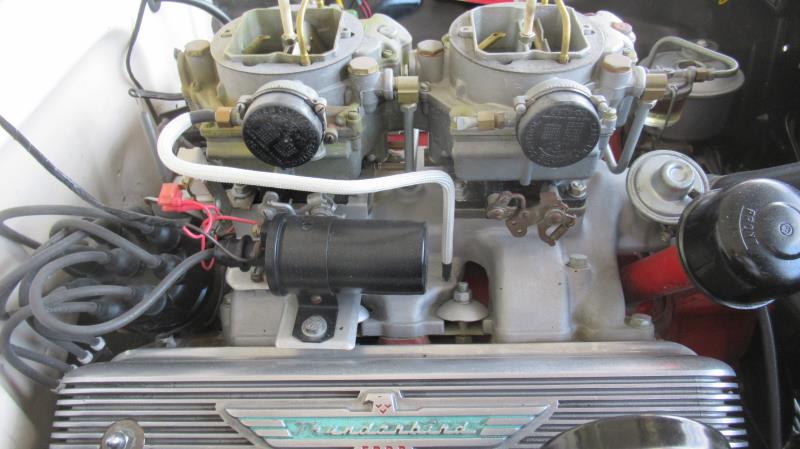 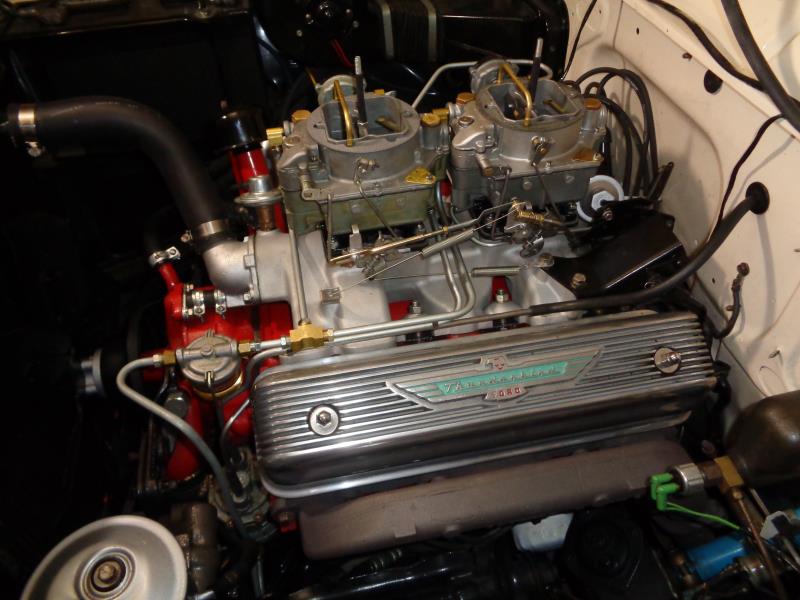
|
|
By Joe D - 7 Years Ago
|
KULTULZ (10/27/2018)
"I don't have a condenser. I have PerTronix electronic points remember?" And I am an old fart that has advanced CRS. Please remember that...  Do you know if you have the IGNITOR I or II? The invoice from speedway just says pertronix (6-2015). If you cannot determine a vacuum leak at the actual occurrence timing, you will most likely have an internal carb(s) problem. Say your intake is not torqued down properly, it may induce a vacuum leak at a certain temp as it is allowed to move. Just something to think about. You need to buy (IMO) a combination vacuum/fuel pressure gauge ($20) just to verify engine condition and tune. Did you kit the carbs at install or were they ready to go? The previous owner had one of the carbs worked on as it was giving him trouble. I did not do the frame off restoration or engine rebuild on my truck. I torqued down on the intake manifold bolts. They seems tight.
|
|
By Joe D - 7 Years Ago
|
Idle is around 1000 rpm, tried different setting with no luck but it seems to like 1000.
The rear carb is the one controlling the idle.
Thanks for the help!
|
|
By KULTULZ - 7 Years Ago
|
"Joe D. Form the begining when you said you had Carter carbs and spacers I assumed AFB's. By the photo of the engine in the truck and the other side view your carbs are Carter small base WCFB's off 55-56 Mercurys. They were used only with Loadmatic distributors which maybe part of your problem. Ted Eaton showed how to modify the teapot Holley to run with the later dist but no one I know has modified these carbs which were also used on Lincolns. I can tell by the vacuum system to open the secondaries. I have a few of these carbs also."
... hmm ...
THANX for the wake-up call ...
"Dual Quads (Carter) are off of a 1957 T -Bird I was told.."
The intake may be 57 BIRD but not the WCFB's.
If these are MERC WCFB carbs, they will be LOAD-O-MATIC modified (CARTER FACTORY) to use with a LOAD-O-MATIC distributor. Shown is a photo showing location of the SPARK CONTROL VALVE-
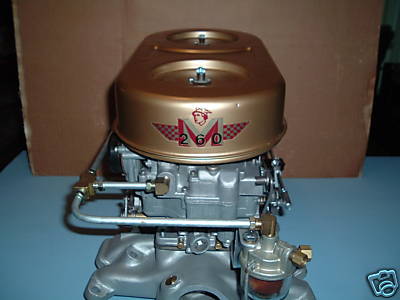
Do you see the SCV under the fuel inlet line? Do you see this valve on either of your carbs? Do you know if your distributor is LOM or 57/ Dual Advance?
May have stumbled across the reason for the shutdown between gears. I will explain once you determine what you have.
Curb idle @ 1000RPM? You either have some type of vacuum leak or one hell of a cam.
|
|
By DryLakesRacer - 7 Years Ago
|
On you tube I've a short video. (Y-Block dual quads) in drive mine idles at 625. The only time mine shows any quirks is after a long run at freeway speeds and coming to stop I sometimes must put it in nuetral. Don't know way but it acts like it's loaded up but there is no black smoke or smell. I do "open it up" every month or so to flow fuel out of every jet and seeing 90-95 mph makes me feel good.
I also have a Lincoln small base Carter WCFB with an aluminum base. It has the vacuum actuator secondaries but no spark control valve on the front. I bought rebuilt on E-bay many years ago and small tag on it said 57 Lincoln and the brass triangle tag matched by a search by me on the Internet.
|
|
By KULTULZ - 7 Years Ago
|
Is your DIST LOM or Dual Advance? If Dual Advance, ported or manifold vacuum (if you are using a vacuum advance)?
I think you said you have GM WCFB's on it.
|
|
By DryLakesRacer - 7 Years Ago
|
KULTULZ, if your askin me and not JoeD, Mine is a 57-up, I mentioned I installed it when I put the 1953 Cadillac Carter WCFB on my "A" manifold.
Funny thing is I always liked the Rochester small base 4GC which was the replacement carb on the Cadillacs and 98 Oldsmobiles and I've spent a lot trying to them make on work on my 296" Y. I have perfect ones but none will work correctly. All the GM style WCFB's work great.
Packard, Mopar, Studebaker, are good sources for Small base 4 barrels it seem FOMOCO used the vacuum secondaries.
|
|
By Joe D - 7 Years Ago
|
Thanks! I'm going to try the spacers. Kultulz added a link for the WCFB spacers.
Still trying to imagine how boiling causes flooding. Is it because the floats drop and let too much fuel in at once or what?
|
|
By Joe D - 7 Years Ago
|
KULTULZ (10/27/2018)
"Joe D. Form the begining when you said you had Carter carbs and spacers I assumed AFB's. By the photo of the engine in the truck and the other side view your carbs are Carter small base WCFB's off 55-56 Mercurys. They were used only with Loadmatic distributors which maybe part of your problem. Ted Eaton showed how to modify the teapot Holley to run with the later dist but no one I know has modified these carbs which were also used on Lincolns. I can tell by the vacuum system to open the secondaries. I have a few of these carbs also." ... hmm ... THANX for the wake-up call ... "Dual Quads (Carter) are off of a 1957 T -Bird I was told.." The intake may be 57 BIRD but not the WCFB's. If these are MERC WCFB carbs, they will be LOAD-O-MATIC modified (CARTER FACTORY) to use with a LOAD-O-MATIC distributor. Shown is a photo showing location of the SPARK CONTROL VALVE-  Do you see the SCV under the fuel inlet line? Do you see this valve on either of your carbs? Do you know if your distributor is LOM or 57/ Dual Advance? May have stumbled across the reason for the shutdown between gears. I will explain once you determine what you have. Curb idle @ 1000RPM? You either have some type of vacuum leak or one hell of a cam.
Do you mean that glass fuel bowl looking thing?
Stock cam I was told. Also have to advance the timing quite a bit from 4 degrees TDC for it to run right.
|
|
By KULTULZ - 7 Years Ago
|
"Do you mean that glass fuel bowl looking thing?"
No, On the carb center base is a valve that appears similar to a power valve-
.
|
|
By KULTULZ - 7 Years Ago
|
"Joe D
Still trying to imagine how boiling causes flooding. Is it because the floats drop and let too much fuel in at once or what"
Yes, and-
When heat causes fuel percolation, high pressure is created in the bowl. As the gasoline becomes a vapor, pressure within the bowl forces the vaporized fuel to discharge through the bowl vents flooding the carb. If the boiling happens in the fuel line, excessive pressure, if not relieved through the pump, forces the needle/seat open giving results as as described above.
Now this occurs on a straight with no turning of the vehicle mainly?
|
|
By KULTULZ - 7 Years Ago
|
DryLakesRacer Posted-
"KULTULZ, if your askin me and not JoeD, Mine is a 57-up, I mentioned I installed it when I put the 1953 Cadillac Carter WCFB on my "A" manifold."
Sorry about that. I (or my browser) have difficulty with this format. I will try to be more considerate in the future.
|
|
By Ted - 7 Years Ago
|
The factory dual quad setups idled off of both carbs but those carbs were calibrated to do that. You can experiment with both carbs sharing idle responsibilities and see if that helps. I’ve always felt that the Y engines were happier in day to day driving with both carburetors being synchronized together rather than running off of one for normal driving. I’ll point to the basic intake manifold design for that and by using the synchronized carbs, then the fuel distribution to all eight cylinders is improved.
From your initial description, if the tranny is simply put into neutral when you’re running 50 mph, it dies. Is that correct? Was the engine running rough prior to putting the tranny in neutral? Does the engine shut down by itself if simply allowing it to idle for an extended period of time? Having to hold the throttle open to start the engine and then letting the engine clear itself out once started sounds like a flooding issue. While much of the prior discussion wants to blame ethanol laden fuel, I’ll suggest checking the fuel for the actual ethanol content. I’ve found as much as 30% in pump gasoline advertised as being no higher than 10% so in that case, it could be a problem. In my part of the country, premium fuel has been no more than 5% ethanol although the pumps say the gasoline can contain up to 10%.
What distributor are you running; early (LOM, 56 and older) or late (’57 and newer)? Are you running the engine with the vacuum advance hooked up? I see from the pictures that you’re using the 1956 Ford/Merc Carter carbs and those need some work if using them on a dual quad setup. The Carters are sensitive to varying fuel pressure and as such can be tempermental on float levels if the fuel pressure is varying. As previously mentioned, those ’56 model Carter carburetors are designed to work with the LOM distributors and if the vacuum advance port is used with the later model distributors, then there’s the potential for too much ignition advance at full throttle or high speed cruising. If not using the vacuum advance, be sure that the ports for the vacuum advance in both carburetors are plugged.
Once you get past the stalling problem, you’ll need to address the secondary spring tension. When using carbs in pairs, the air flow cuts in half through each carb. The metering system in some single 4V carbs is not up feeding enough fuel with the reduced air flow when used in pairs and especially if the camshaft is on the rowdy side where manifold vacuum is significantly reduced or there’s some low speed reversion taking place within the intake manifold. Assuming that’s not a problem, then the secondary spring tension needs to be cut in half so the secondaries open up at a reasonable rpm and not at 5500 rpms and above. This doesn’t mean cutting the springs in half but rather fixing the springs so that they have half the tension. For the Holley carbs, spring kits are available to accomplish this. I’ve seen no such spring kits for the Carter carbs as Ford for ’56 and ’57 were the only Carter carbs I’m aware of that used secondary springs. The rest of the auto manufacturers used alternative means to open the secondaries on their Carter 4V carb equipped engines. I’ve simply had to experiment with both the ’56 and ’57 Carter carbs on cutting and heating the spring coils and trying the modified springs on the engine dyno. This would be tough to do on a running vehicle unless performed on a chassis dyno.
Here are pictures of the ’56 Ford/Merc 312 Carter carbs on the dyno being tested.
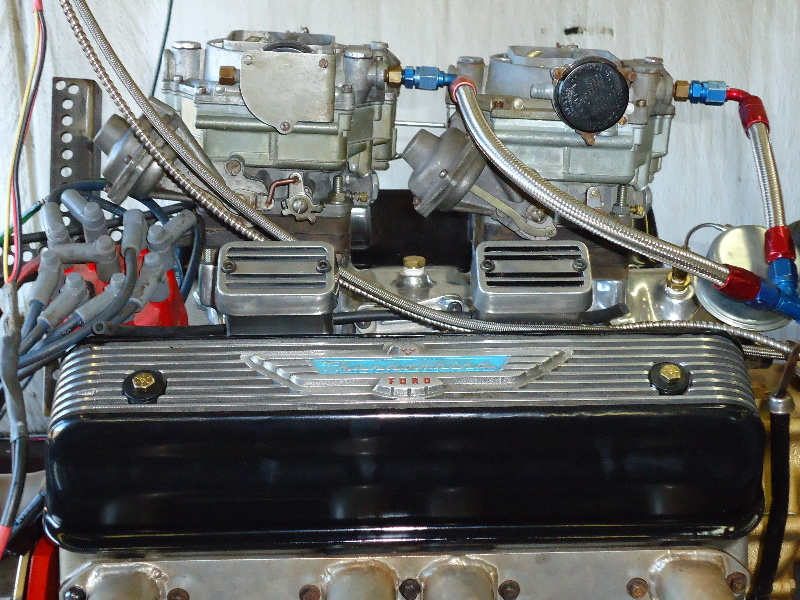
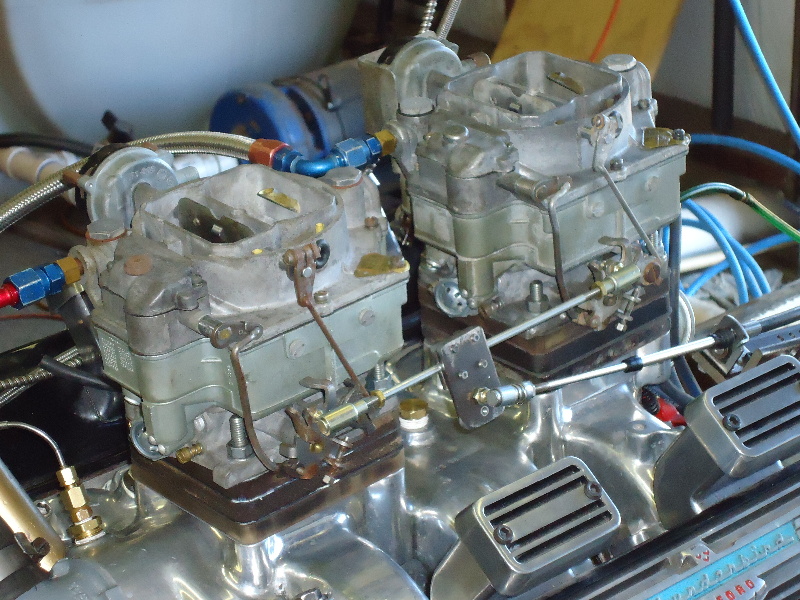
|
|
By Joe D - 7 Years Ago
|
Wow, you guys have really helped me a lot. I'm learning, Thanks!
I believe the distributor is stock and not sure if its dual advance or not. I do know that it really does not change the performance of the engine if I plug it or hook it up to one of the carb ports or the manifold port.
The stalling occurs after highway speeds and accelerating fairly hard. Engine has to be fully heated up (180-195). When load is suddenly taken off by placing in neutral she dies. Tach drops to zero but she always restarts. I can keep her running by goosing the accelerator or down shifting so I'm still driving and trying deferent things that are improvements and don't cost a lot. Yesterday I insulated the fuel lines running along the frame near the headers and the pump discharge line to the carbs. I had some thick insulating tape and it took me about 1/2 hour.
Last night I ordered a set of phenolic spacers (from Dashman $90) for under the carbs to replace the aluminum ones. Thanks Kultulz!
I also learned that WCFB stands for Will Carter Four Barrel. ID ing the carb was huge so I could order the spacers and a kit if needed.
Other than the stalling issue the truck has never run better.
Thanks again Y-blockers!
Joe D
|
|
By Joe D - 7 Years Ago
|
[quote]KULTULZ (10/28/2018)
"Joe D Still trying to imagine how boiling causes flooding. Is it because the floats drop and let too much fuel in at once or what" Yes, and- When heat causes fuel percolation, high pressure is created in the bowl. As the gasoline becomes a vapor, pressure within the bowl forces the vaporized fuel to discharge through the bowl vents flooding the carb. If the boiling happens in the fuel line, excessive pressure, if not relieved through the pump, forces the needle/seat open giving results as as described above. Now this occurs on a straight with no turning of the vehicle mainly?
|
|
By Joe D - 7 Years Ago
|
Ted (10/28/2018)
The factory dual quad setups idled off of both carbs but those carbs were calibrated to do that. You can experiment with both carbs sharing idle responsibilities and see if that helps. I’ve always felt that the Y engines were happier in day to day driving with both carburetors being synchronized together rather than running off of one for normal driving. I’ll point to the basic intake manifold design for that and by using the synchronized carbs, then the fuel distribution to all eight cylinders is improved. From your initial description, if the tranny is simply put into neutral when you’re running 50 mph, it dies. Is that correct? yes only when up to atleast 180 degrees for a while. Was the engine running rough prior to putting the tranny in neutral? No it runs great. Does the engine shut down by itself if simply allowing it to idle for an extended period of time? No never. Having to hold the throttle open to start the engine and then letting the engine clear itself out once started sounds like a flooding issue. While much of the prior discussion wants to blame ethanol laden fuel, I’ll suggest checking the fuel for the actual ethanol content. I’ve found as much as 30% in pump gasoline advertised as being no higher than 10% so in that case, it could be a problem. In my part of the country, premium fuel has been no more than 5% ethanol although the pumps say the gasoline can contain up to 10%. I can ask a refinery lab tech since I work at a refinery that supplies Sunoco with their fuel in the Philly area. I do know since I used to blend gasoline that they add more light end components in the winter season (high vapor pressure) as opposed to (low vapor pressure) in the summer months. What distributor are you running; early (LOM, 56 and older) or late (’57 and newer)? Are you running the engine with the vacuum advance hooked up? I see from the pictures that you’re using the 1956 Ford/Merc Carter carbs and those need some work if using them on a dual quad setup. The Carters are sensitive to varying fuel pressure and as such can be tempermental on float levels if the fuel pressure is varying. As previously mentioned, those ’56 model Carter carburetors are designed to work with the LOM distributors and if the vacuum advance port is used with the later model distributors, then there’s the potential for too much ignition advance at full throttle or high speed cruising. If not using the vacuum advance, be sure that the ports for the vacuum advance in both carburetors are plugged. Once you get past the stalling problem, you’ll need to address the secondary spring tension. When using carbs in pairs, the air flow cuts in half through each carb. The metering system in some single 4V carbs is not up feeding enough fuel with the reduced air flow when used in pairs and especially if the camshaft is on the rowdy side where manifold vacuum is significantly reduced or there’s some low speed reversion taking place within the intake manifold. Assuming that’s not a problem, then the secondary spring tension needs to be cut in half so the secondaries open up at a reasonable rpm and not at 5500 rpms and above. This doesn’t mean cutting the springs in half but rather fixing the springs so that they have half the tension. For the Holley carbs, spring kits are available to accomplish this. I’ve seen no such spring kits for the Carter carbs as Ford for ’56 and ’57 were the only Carter carbs I’m aware of that used secondary springs. The rest of the auto manufacturers used alternative means to open the secondaries on their Carter 4V carb equipped engines. I’ve simply had to experiment with both the ’56 and ’57 Carter carbs on cutting and heating the spring coils and trying the modified springs on the engine dyno. This would be tough to do on a running vehicle unless performed on a chassis dyno. A lot of this stuff is way over my head but I do know some great mechanics like you! Here are pictures of the ’56 Ford/Merc 312 Carter carbs on the dyno being tested.


|
|
By DryLakesRacer - 7 Years Ago
|
JoeD, this may seem a little primative and others will probably chime in. To check which distributor you have just take off the cap and try to turn the rotor. If it will not move in either direction it's a Loadmatic. If it will move in one direction about 10-12* it is a centrifugal, which is 57-up. Also stick a long enough hose on the distributor can filling and suck on it to see if the plate moves, if it does that will prove your vacuum can is working. If it will stay moved with your tongue tip over the end of the hose the can is good.
Your truck is a 1960. I cannot believe your dist is a loadmatic.
As Ted stated the Merc WCFB's were used with loadmatics in 55-56 and were not compatible with the 57-up distributors that's why I first went to the GM carbs because they were.
There were many of the guys I knew back in the 60's who ran their distributor vacuum off manifold and not ported and made them work. The engine would always idle faster and the just turned them down. Others ran no vacuum and set the advancing springs as light as possible and kept total advance around 34-37 degrees and just lived where initial advance showed on the balencer. We were just kids, what did we know anyway.
We all have ideas that seem to work. Eventho I'm a California guy I've met Ted and watched him do dyno pulls (thanks to Karol Miller) and he has done more tests and ran every combination known to man on a Y-Block and I take his word as gospel. He and so many others on this site have helped me iron out problems which have never happened to me before and cannot thank them enough.
You will figure this out.
|
|
By oldcarmark - 7 Years Ago
|
DryLakesRacer (10/28/2018)
JoeD, this may seem a little primative and others will probably chime in. To check which distributor you have just take off the cap and try to turn the rotor. If it will not move in either direction it's a Loadmatic. If it will move in one direction about 10-12* it is a centrifugal, which is 57-up. Also stick a long enough hose on the distributor can filling and suck on it to see if the plate moves, if it does that will prove your vacuum can is working. If it will stay moved with your tongue tip over the end of the hose the can is good. Your truck is a 1960. I cannot believe your dist is a loadmatic. As Ted stated the Merc WCFB's were used with loadmatics in 55-56 and were not compatible with the 57-up distributors that's why I first went to the GM carbs because they were. There were many of the guys I knew back in the 60's who ran their distributor vacuum off manifold and not ported and made them work. The engine would always idle faster and the just turned them down. Others ran no vacuum and set the advancing springs as light as possible and kept total advance around 34-37 degrees and just lived where initial advance showed on the balencer. We were just kids, what did we know anyway. We all have ideas that seem to work. Eventho I'm a California guy I've met Ted and watched him do dyno pulls (thanks to Karol Miller) and he has done more tests and ran every combination known to man on a Y-Block and I take his word as gospel. He and so many others on this site have helped me iron out problems which have never happened to me before and cannot thank them enough. You will figure this out.
Take the Cap off. If U can see Springs its a Loadomatic. No Springs visible makes it a Dual Advance 57+ Distributor.
|
|
By charliemccraney - 7 Years Ago
|
Or, with the distributor cap off:
Load-O-Matic, advance springs visible
Centrifugal, advance springs not visible.
I run manifold vacuum because more advance does help an engine to idle cooler and it does feel ever so slightly more responsive right off idle than ported vacuum. There's not much to make work with this vs ported. Adjust idle speed down, readjust mixture screws and that's about it. The functional difference between the two is at idle, no additional advance with ported, full vacuum advance with manifold. Just above idle, ported becomes manifold and they work the same.
In the case here, ported is not an option and it must be manifold or nothing.
|
|
By KULTULZ - 7 Years Ago
|
I think all of this boils down to a mis-match of parts, not know whether the carburetion/ignition is LOM or DUAL ADVANCE, or a possible combination of either..
The vacuum secondary WCFB was offered (by LINC-MERC) in both LOM and DUAL ADV (1957/ ).
That said, we need to know if the carb(s) has a SPARK CONTROL VALVE and DIST TYPE. It would also be helpful to know the INTAKE ID.
The 1st photo shows a LOM DIST BOWL and the second a 57/59 DUAL ADVANCE.
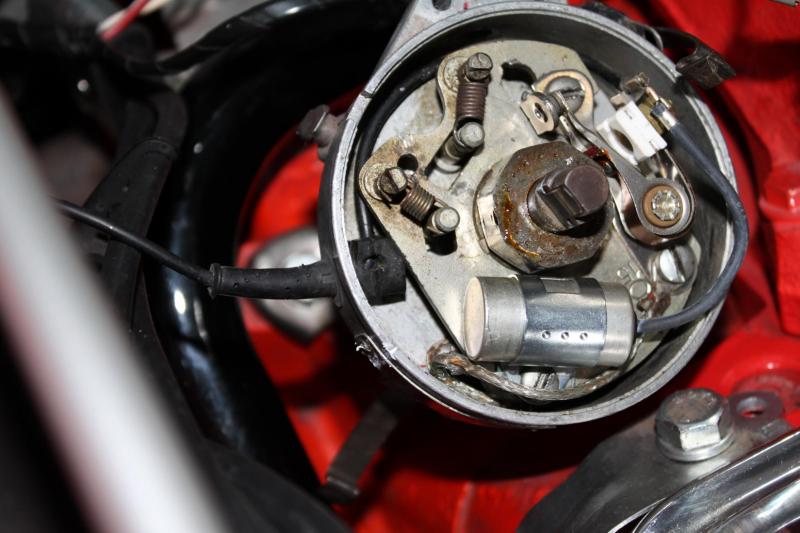
|
|
By KULTULZ - 7 Years Ago
|
PART II
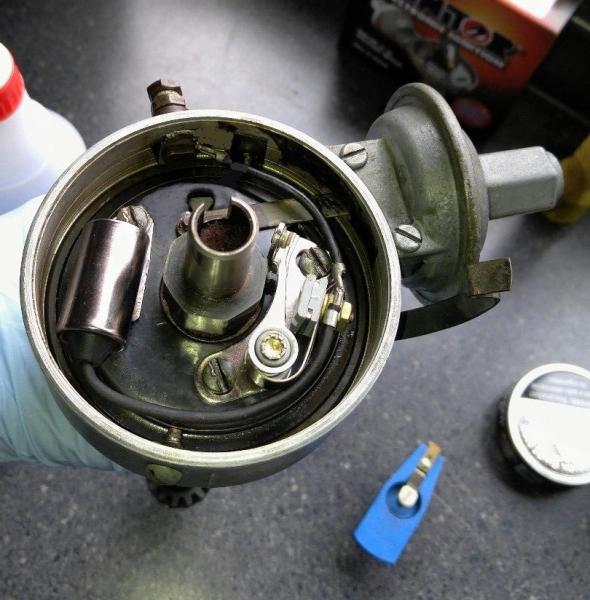
The LOM was a system using modulated MANIFOLD VACUUM. This system (manifold vacuum use) has it's drawbacks and FORD addressed those with the 56 DUAL PORT DIAPHRAM vacuum advance.
What is needed now is positive ID of components.
As for TED EATON, he is the man, plain and simple.
|
|
By Joe D - 7 Years Ago
|
|
Ok, I'll find out what parts I have tonight,
Distributor type? Original equipment Dual Advance distributor. I checked the vacuum advance with a hose and it moves and holds vacuum. Thanks DryLakes Racer! Easy test!
Manifold markings? 5-13 See photo to be added
WCFB Carb spark control valve? See photo to be added
While checking distributor and wires I noticed #5 spark plug was loose as it was turning as I moved the spark plug boot. Maybe Stalling issue??
Saturday I removed an old choke mechanism from the front carb since it was never hooked up. While running engine discovered vacuum leak where the choke was. A small tube sticking out a little where the choke mechanism once was.
Test drove: Ran great and idling around 1000 rpm. Seems like I can not get idle any lower with the idle screws on front and back carbs. Screws all the way out. Vacuum advance hooked up to back carb port, manifold port capped.
Did not run long enough to test stalling issue. Hope to drive 21 miles to work tomorrow. That will be a good test.
Ethanol Free gasoline search in Philly area - You have to go to Reading area (1 1/2 Hr. from me) to find it out of a pump or by it in a 5 gallon can (95 octane) for around $50. You can get higher octane racing fuel also VP Racing 100,109,110.
I Talked to a refinery Lab Tech and he believes all gas in philly area has 10% added to it. 87 OCT and 93 OCT. I thought less was added to the 93 OCT before I spoke to him.
Thanks to all for the info!
Joe D
|
|
By Joe D - 7 Years Ago
|
DryLakesRacer (10/28/2018)
JoeD, this may seem a little primative and others will probably chime in. To check which distributor you have just take off the cap and try to turn the rotor. If it will not move in either direction it's a Loadmatic. If it will move in one direction about 10-12* it is a centrifugal, which is 57-up. Also stick a long enough hose on the distributor can filling and suck on it to see if the plate moves, if it does that will prove your vacuum can is working. If it will stay moved with your tongue tip over the end of the hose the can is good.
Your truck is a 1960. I cannot believe your dist is a loadmatic. Thanks I will perform this test and report back.
As Ted stated the Merc WCFB's were used with loadmatics in 55-56 and were not compatible with the 57-up distributors that's why I first went to the GM carbs because they were.
There were many of the guys I knew back in the 60's who ran their distributor vacuum off manifold and not ported and made them work. The engine would always idle faster and the just turned them down. Others ran no vacuum and set the advancing springs as light as possible and kept total advance around 34-37 degrees and just lived where initial advance showed on the balencer. We were just kids, what did we know anyway.
We all have ideas that seem to work. Eventho I'm a California guy I've met Ted and watched him do dyno pulls (thanks to Karol Miller) and he has done more tests and ran every combination known to man on a Y-Block and I take his word as gospel. He and so many others on this site have helped me iron out problems which have never happened to me before and cannot thank them enough.
You will figure this out.
Thanks old pal!
Joe D
|
|
By KULTULZ - 7 Years Ago
|
Joe D Posted-
"Ethanol Free gasoline search in Philly area - You have to go to Reading area (1 1/2 Hr. from me) to find it out of a pump or by it in a 5 gallon can (95 octane) for around $50. You can get higher octane racing fuel also VP Racing 100,109,110."
Just a thought. If you are in the Philly area, ethanol free gasoline is also usually sold in marinas and may not be listed in the fuel reference site. Common areas to find are agricultural regions, small airports and marinas
Waiting for more definite engine assembly details/photos..
|
|
By Joe D - 7 Years Ago
|
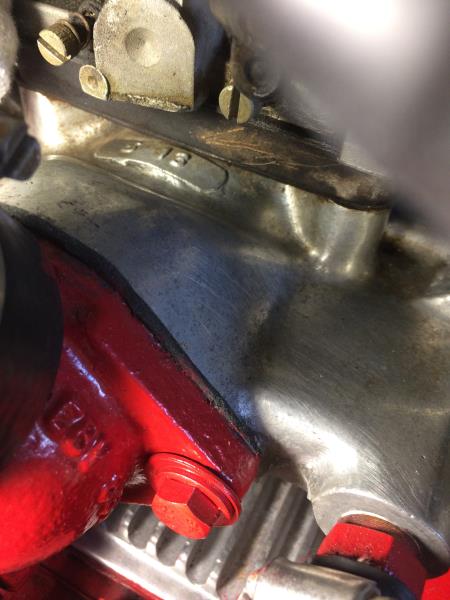
Manifold 5-13, off of a 57 T-bird According to previous owner.
|
|
By Joe D - 7 Years Ago
|
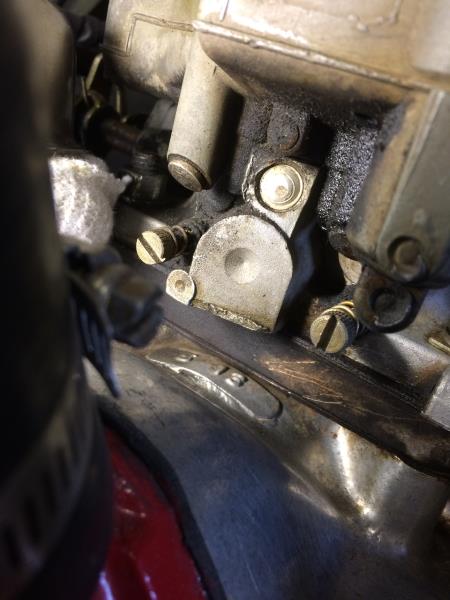
Bottom of front carb. Spark Valve?
|
|
By Ted - 7 Years Ago
|
|
If you cannot get the engine to idle down with the idle mixture screws backed all the way out, then I’ll suggest removing the carbs from the manifold and checking out the carbs in detail. First off look at the rear secondaries to insure that they are completely seated when closed. If the throttle blades have been removed from their shafts in the past, then there’s a good chance the assembler did not get the blades properly realigned on the shafts and you have one or more blades out of sync with the others simply making for an uncontrolled air leak. Hence the failure to get the engine to properly idle down with the idle control screws.
|
|
By Joe D - 7 Years Ago
|
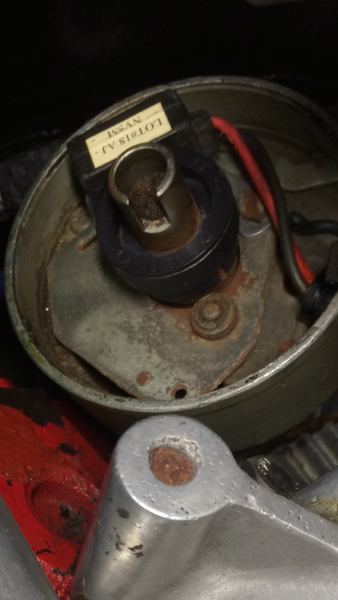
Stock 1960 F-100 MD 292 V-8 Dual Advance Distributor with Pertronix electronic points. Not Pertronix II. I was told there is no Pertronix I. Bought them in 2015. Checked vacuum advance with hose (DryLakesRacer) and it moved and held vacuum.
Drove to work this morning and ran great until I got off the highway and place her in neutral. Engine died again and restarted by placing back in gear and had to goose the accelerator to keep her running. Idled kind of rough between 800-900. Before this happens its idling at 1000 and smooth. Coolant temp went to around 190 as I parked and let it idle rough.
Hope the phenolic spacers Work!!
Thanks Y-Blockers!
Joe D
|
|
By Ted - 7 Years Ago
|
|
Thanks for the detailed pictures of the front of your carb. Do you have the Carter carb numbers stamped on your carbs handy? No spark control valves and vacuum secondary diaphragms makes this carb an oddity.
|
|
By Joe D - 7 Years Ago
|
The only numbers I can find is on the top of each carb, throttle side - 6-1273
on the front Patent Re 21610 followed by a bunch of other patent numbers. The previous owner said they and the intake were off of a 57 T-Bird.
When I take the carbs off to install the Phenolic spacers I'll get someone to look at them with your suggested checks. I'm certainty not qualified for that inspection.
Thanks for the help!
Joe D
|
|
By charliemccraney - 7 Years Ago
|
|
1000rpm idle is pretty high. Unless you have a cam that requires that, it could be a clue to what's happening. Is there a reason for that idle speed?
|
|
By KULTULZ - 7 Years Ago
|
OK, so now we know it is not LOM. The CARB style points to 1957 MERC (368 CI) and 1957 LINC (368 CI).
As Ted has posted, most likely now the problem(s) lie within the carb and/or throttle linkage. Make sure when inspected the secondaries close completely. When you adjust multi-carbs, you do so with linkages removed. Once satisfied with carb balance (your system is using two primary carbs), you then install linkage and adjust from there.
BTW- If the intake manifold is FORD 1957 8V (ECG-9424-D), it takes a special valley cover pan to allow the bottom of the intake not to overheat and be subject to damage.
NOTE TO SELF- Could the throttle bores/plates be larger on the 57 WCFB and be causing the interference if any?
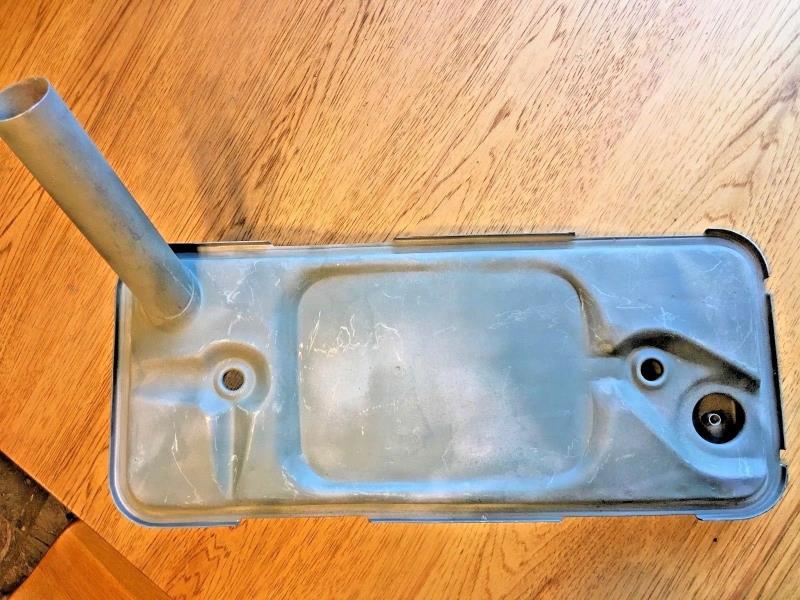
|
|
By Joe D - 7 Years Ago
|
|
Charlie McCraney, No reason for the high idle (1000 rpm). I spoke to the guy who did the restore and he said when he tried to back it down it did not run right. I did try to lower recently but the idle screws where all the way backed out. (see other posts and comments).
Kultulz, When I take the carbs off to install spacers I will have someone inspect, rebuild or replace with something less unusual! A friend of mine suggested EFI but I kind of like the dual quads carburetors. Old school cool, you know?
Any suggestions on a set of carbs that would be good for this application?
What is that a picture of??
NOTE: The truck ran good for 3 years before I had this stalling issue after heating up. The previous owner said he drove it for 4 years or so without any issues also.
Thanks Y Blockers!
Joe D (The Frig)
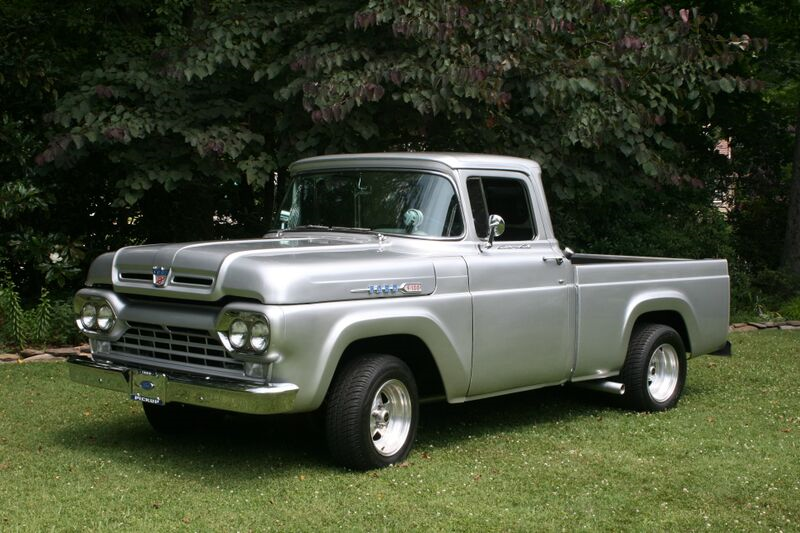
|
|
By DryLakesRacer - 7 Years Ago
|
A lot has been discussed here. Teds response saying both need to be set up to work at idle definately worked for me. If your going to keep them and I would you might want what I show in the enclosed photos. It is an Edelbrock Uni-Syn for synconizing mult-carb engines. All 3 parts I made mine from are available from Summit and others. The aluminum cap is for a 5-1/8" carb with a 1-1/4" hole in it and the black adapter is plastic for a 4-7/8" carb to to the top cap. Its attached with RTV. About $45 for odd the parts. Once I set mine I've checked it only one other time. The number isn't as important as them being equal.
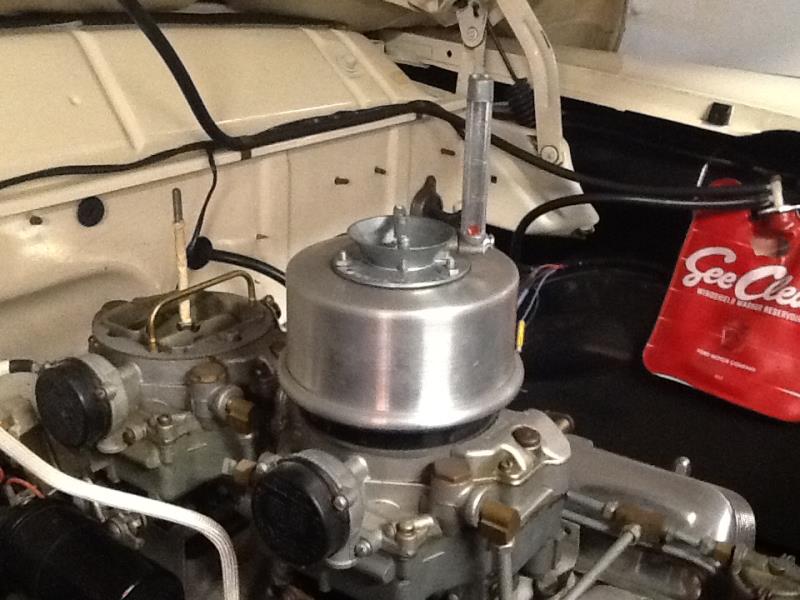
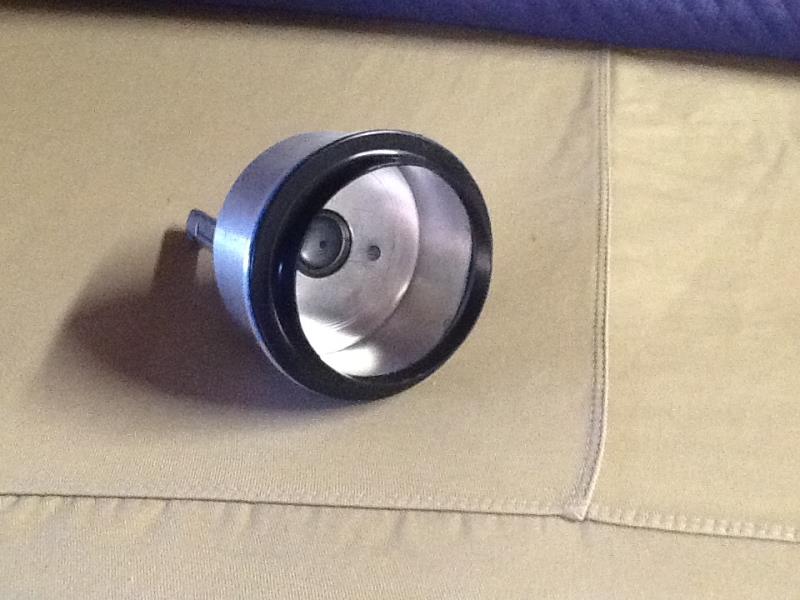
|
|
By KULTULZ - 7 Years Ago
|
"Kultulz, When I take the carbs off to install spacers I will have someone inspect, rebuild or replace with something less unusual! A friend of mine suggested EFI but I kind of like the dual quads carburetors. Old school cool, you know?
Any suggestions on a set of carbs that would be good for this application?
What is that a picture of??"
I would try and use what you have (they are FORD issue). Most likely, the problem(s) is in either the carb(s) or linkage adjustment. Maybe something binds when hot and not cold? Will cause a vacuum leak and very lean mixture and she wants to shut down.
The photo is of a valley pan especially for the 1957 E-CODE (8V). Re-read the description.
|
|
By KULTULZ - 7 Years Ago
|
Joe-
Did this 8V setup come with the truck or you bought the set as a take-off and installed them yourself?
Regarding balancing carbs, watch this- https://www.youtube.com/watch?v=mNzjAyHAl0A
|
|
By Joe D - 7 Years Ago
|
I did not put this set up together. I bought the truck 3 1/2 years ago from a small dealer. It was about 80% finished. I recently talked to the owner from Ohio who did the restoration. I found him through receipts that came with the truck. This is a sign he made that came with the truck. Sorry I tried to flip it!
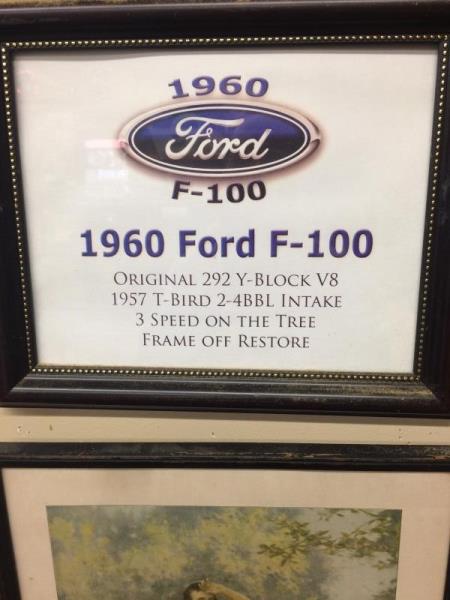
|
|
By KULTULZ - 7 Years Ago
|
THANX for that!
So the truck was bought with the 8V assembled on the engine? Was the drive-ability problem noticed at purchase or started later?
|
|
By Joe D - 7 Years Ago
|
I did not assemble the engine KultulZ. Issue started this year back in March and seems to be getting worse lately. I drove for 3 years without the issue. This morning after restating it did recover but took several minutes before it returned to somewhat steady 1000 rpm.
Does anyone know someone or a good company that I could ship carbs to and have them rebuild and adjust.
|
|
By KULTULZ - 7 Years Ago
|
Sounds like they need to be gone through. That's the trouble with multi-carburetion, it's neat but requires more maintenance.
I forgot to ask, is the vacuum signal to the DIST ported or manifold?
Also when you applied lip vacuum (in lieu of a MITY-VAC) to the DIST advance canister and after confirming it held vacuum, did you notice free movement of the top plate, both advance and retract. No binding?
|
|
By Joe D - 7 Years Ago
|
The distributor vacuum advance is hooked up to a port on the rear carb. I also tried the manifold vacuum and also plugging vacuum advance off and did not really notice any difference in performance so I hooked it back up the way it was when I bought the truck.
When performing the lip vacuum test, I varied the vacuum applied to the diaphragm and the plate seemed to slide back and forth with no binding or erratic movements. However, after performing this test procedure, I did feel a little light headed and I needed to sit down for awhile !! 
|
|
By DryLakesRacer - 7 Years Ago
|
Joe, do you open it up every so often? I do about once a month. You need to flow fuel thru all 8 barrels. That's what happened to a lot of 3-2 and 2-4 sets ups from the factory. Grandma didn't do it. Fords Y's were not progressive as Ted said and Carters and Rochesters have fairly long arms on their floats which do change on a vibrating/running engine. I haven't touched mine in 5 yrs after synconizing them and other than a little less fuel milage I see no reason to remove them. It also sounds like you also have a minor vacuum leak. Check the bottoms of your carbs really close when installing the isolation plates. I'd run a flat body file over both and check the manifold surface too.
Remember to get 4 new gaskets ( small base) I thing the guy who I got my plates from sold them. They should be soft..not crispy critters.. that will make the best seal.
|
|
By Joe D - 7 Years Ago
|
I do open her up often. Today is the third day I drove her into work this week and it's 21 miles of highway driving each way. I'll look over the carbs real good and have a someone else check them as well since I'm a novice. I'll keep you updated. Yesterday while adjusting the idle on the front carb I heard a whistling sound but could not figure out where it was coming from? Maybe from inside the carb throat since I have the air cleaners off.
Thanks again! I'll keep you Y-Blockers updated.
Joe D (The Frig)
|
|
By KULTULZ - 7 Years Ago
|
Don't forget to get back as I wish to know what you finally come across... 
|
|
By Joe D - 7 Years Ago
|
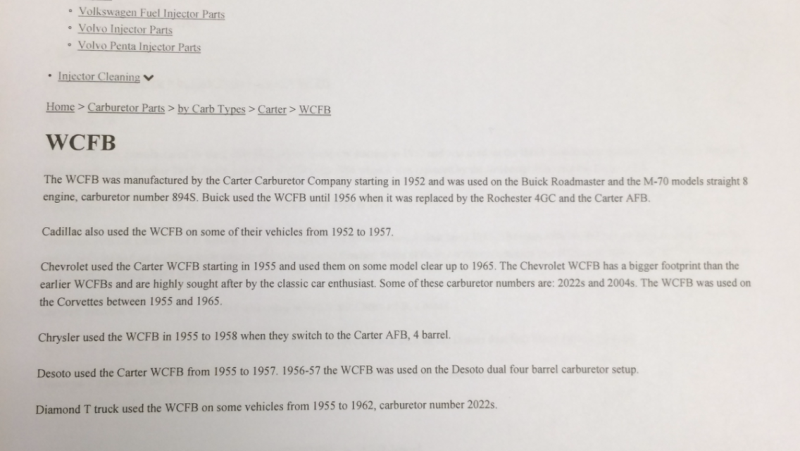
|
|
By Joe D - 7 Years Ago
|
That's a cool video. I'm gone make one of those instruments!
Thanks, Joe D
|
|
By Joe D - 7 Years Ago
|
DryLakesRacer (10/30/2018)
A lot has been discussed here. Teds response saying both need to be set up to work at idle definately worked for me. If your going to keep them and I would you might want what I show in the enclosed photos. It is an Edelbrock Uni-Syn for synconizing mult-carb engines. All 3 parts I made mine from are available from Summit and others. The aluminum cap is for a 5-1/8" carb with a 1-1/4" hole in it and the black adapter is plastic for a 4-7/8" carb to to the top cap. Its attached with RTV. About $45 for odd the parts. Once I set mine I've checked it only one other time. The number isn't as important as them being equal.  
Thanks I'm going to make one of those!
He is adjusting the mix screws right, not just the idle?
Joe D
|
|
By KULTULZ - 7 Years Ago
|
Well, actually both. You disconnect the linkage(s) and adjust mixture on each carb to get the best idle and then use the UNI-SYN to match balance/same idle speed. Then you go to the linkage(s). Then re-check with the UNI-SYN.
The trouble is with solids and multi carb, you need to go over it frequently to keep all in tune.
.
|
|
By Joe D - 7 Years Ago
|
Thanks Kultultz!
I ordered a uni sync and vacuum gage test kit and received the insulated spacers and gaskets yesterday.
DryLakesRacer
The gaskets are nice and spongy and not crispy critters!
Should these gaskets be sealed with Gaskacinch or just put on dry as they come?
|
|
By KULTULZ - 7 Years Ago
|
Dry and make sure both carb(s) and intake carb pad(s) are clean and flat.
Torque to spec.
|
|
By Sandbird - 7 Years Ago
|
|
Did you ever consider trying a 160 deg, thermostat to see how things work out?
|
|
By Joe D - 7 Years Ago
|
I actually have a 160 degree thermostat and I drilled a 1/8 hole it to always keep a flow going through it. I was told this helps prevent pump cavitation.
The engine cooling system has never boiled over and the hottest its ever gotten is around 195.
Thanks Sandbird!
Joe D
|
|
By Joe D - 7 Years Ago
|
KULTULZ (11/2/2018)
Dry and make sure both carb(s) and intake carb pad(s) are clean and flat. Torque to spec.
Ok, I'll make sure they are nice and clean and flat, especially since this could be a vacuum leak.
|
|
By Joe D - 7 Years Ago
|
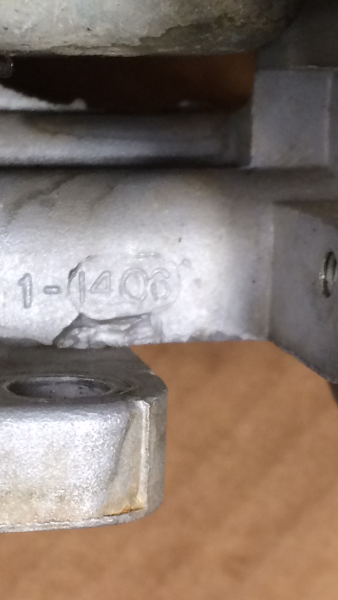
|
|
By Joe D - 7 Years Ago
|
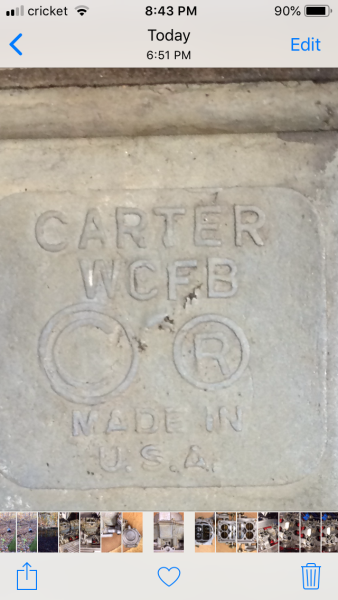
|
|
By Joe D - 7 Years Ago
|
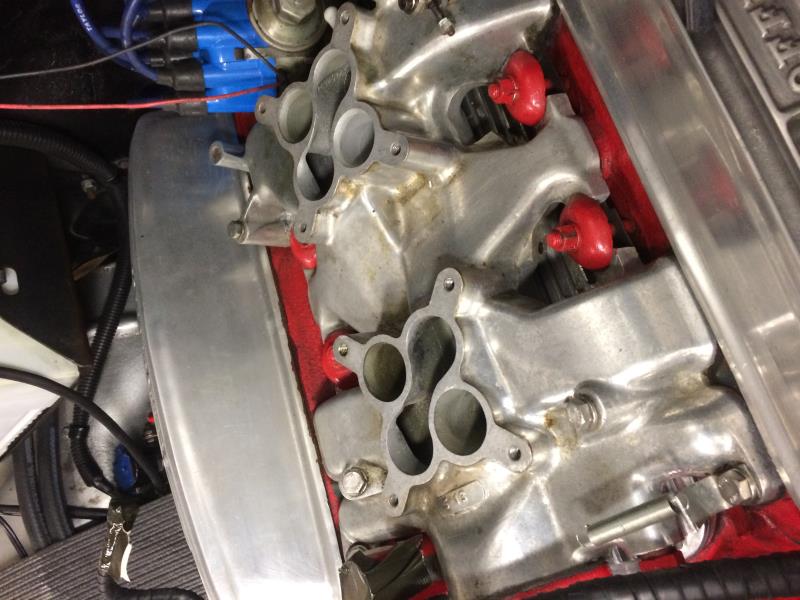
|
|
By Joe D - 7 Years Ago
|
I removed carbs. Hopefully I can ID to be able to get rebuild kit. Not sure if 1-(1406) means anything?
Also manifold ID 5-13 mean anything?
Front carb primary and secondary valves did not snap shut as well as the rear carbs did when manually operated off the engine Possible issue with secondary's not closing like Ted had mentioned?
Thanks Y blockers!
Joe D
|
|
By Joe D - 7 Years Ago
|
Also manifold where carbs mount seem nice and flat and true. Gaskets and spacers seemed to be ok. They are composite and not aluminum like I thought. Oh well I guess its not fuel boiling in the carbs.
|
|
By Joe D - 7 Years Ago
|
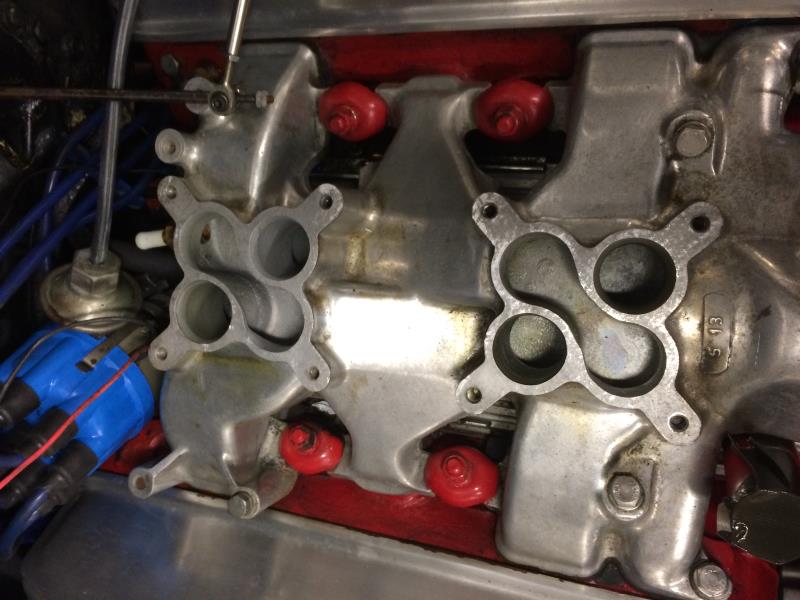
|
|
By KULTULZ - 7 Years Ago
|
Joe D (11/5/2018)
I removed carbs. Hopefully I can ID to be able to get rebuild kit. Not sure if 1-(1406) means anything?
Front carb primary and secondary valves did not snap shut as well as the rear carbs did when manually operated off the engine Possible issue with secondary's not closing like Ted had mentioned? The operation of the throttle shafts/blades is your first step. Sounds like you found your first defect. The blades have to operate freely in the bores. Now for some bad news. It seems CHRY used this same design also (vacuum secondaries). So without the ID TAGS it is going to be difficult to ID and find the correct kit/parts. The CASTING ID NO you showed (and others) can be used to ID a carb, but all the references I have come across seems to be GM. I am going to E-MAIL you a possible source of info about this CARB SERIES as I don't know if posting it is allowed. Whatever happens or you decide to do please let the board know as I am on a steep learning curve here.
|
|
By Joe D - 7 Years Ago
|
KultulZ
I gave up on ID ing the carbs and finding the right kits for them. Even if I found one I would then I'd have to find someone to do the rebuild because It's above my capabilities.
I'm sending them out tomorrow to be rebuilt and hopefully have them back in 2 weeks.
I'll be asking for help when I have them re installed and it comes time to adjust them. I should have my uni-sync ready by then and my new vacuum gage kit!
Thanks Again!
Joe D
|
|
By KULTULZ - 7 Years Ago
|
|
COPY!
|
|
By Joe D - 7 Years Ago
|
Well I got the carbs back reinstalled and test drove. Still stalling after up to temp!!!! Runs great until up to 180 degrees.
Carb idle screws backed all the way out. Idles around 1000 RPM. Mix screws backed out two turns. tried to adjust but really didn't seem to change how it idled. Carbs are synched at idle. Manifold vacuum reading 14 " at 1000RPM.
Drove to work this morning and stalled coming off of highway and I could not keep it idling without goosing the accelerator. Before carbs were rebuilt it seemed to recover after a couple of minutes of goosing and idling. Matbe because mix screws are not adjusted yet.
HELP!!!! Y Blockers!!!
Joe D
|
|
By KULTULZ - 7 Years Ago
|
 ... ain't this a b!tch ... ... ain't this a b!tch ...
Wherever you sent the carbs, was he able to ID them and also as a matched set or different models?
Do you know if the set has a PRIMARY and SECONDARY (or both primary) carb and are you using direct linkage or progressive linkage? Did the guy you bought it from give any info on the cam installed? This is using a 57/ DUAL ADVANCE DIST?
1000RPM curb idle has to hide one heck of a cam (or vacuum leak).
Let me re-read all of th posts again.
|
|
By Joe-JDC - 7 Years Ago
|
|
Every time I read your entries, I come back to the idea that happened to me with a similar situation with stalling, idling ok, and stalling after driving a short distance. After rebuilding my carb, changing everything, plugs, points, cap, rotor, etc., it would crank up fine, idle fine, but stall when I drove a short distance, or came to a stop. I finally traced it down to a fuel filter that was pulling sediment up against the opening and closing it off, especially under deceleration. When the car stopped, the sediment settled back level with the filter, and fuel would fill the carb bowl and the engine would start and idle just fine. Changed the filter and no more problem, until the filter started clogging up again. These older fuel systems need to be flushed occasionally, if possible, to remove any moisture from the oxygenated fuel that settles to the bottom of the tank. The moisture will cause the tank to rust if not removed immediately with fresh fuel, or a moisture agent to mix it with the fuel again. Had the similar experience with EFI, and added a bottle of fuel injector cleaner with additive to remove moisture, and skipping went away almost immediately. Joe-JDC
|
|
By KULTULZ - 7 Years Ago
|
|
Every time I read your entries, I come back to the idea that happened to me with a similar situation with stalling, idling ok, and stalling after driving a short distance. After rebuilding my carb, changing everything, plugs, points, cap, rotor, etc., it would crank up fine, idle fine, but stall when I drove a short distance, or came to a stop. I finally traced it down to a fuel filter...
... hmm ....
Where is the filter on the supply side? I remember your saying you removed the inlet screens.
A 10 micron filter @ the pickup will not stop all trash. That is for accidental ingestion of Godzilla or perhaps a midget submarine. Didn't you say that it has a new fuel tank?
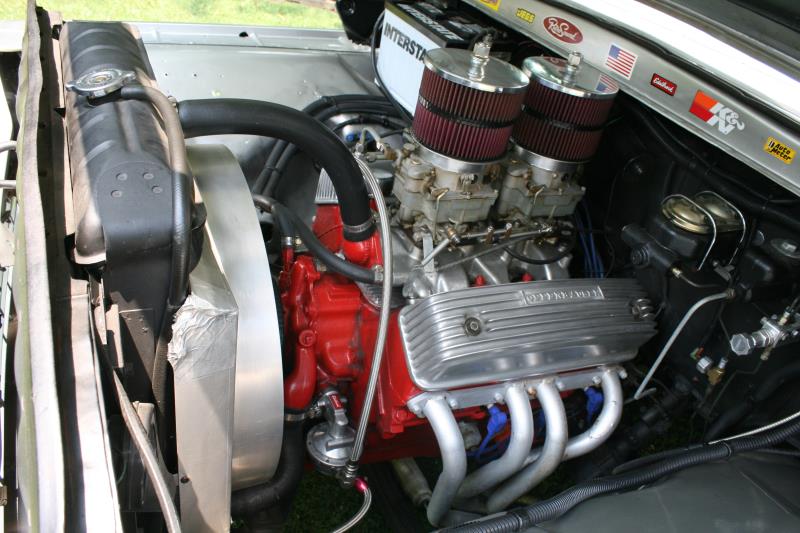
 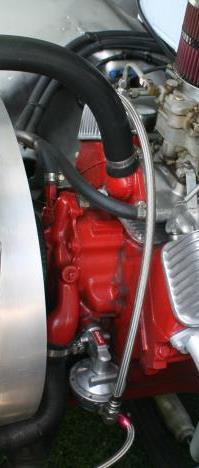
That cross-over fuel line worries me. Too close to the radiator hose.
|
|
By Joe D - 7 Years Ago
|
|
Kultulz,
The guy who rebuilt the carbs was not interested in trying to IDing. He said they had all the parts and would rebuild.
I know they are Carter WCFB with vacuum operated secondary's
The linkage operates the rear carb first and then the front carb as you accelerate more.I guess that's progressive right?
I would like to have them operate together for daily driving as advised in an earlier post.
Stock cam was used in rebuild the previous owner said.
I believe its a dual advance distributor as stated in earlier post.
Thanks for your help!
Joe JDC
I installed a high flow canister type of racing filter that is mounted back by the fuel tank. I had a small clear glass one before the pump suction and I thought that it could be causing pump cavitation or a restriction.
New fuel tank, new fuel lines, new mechanical fuel pump, new fuel filter and rebuilt carbs with screens in the inlet.
I did try running truck with the gas fill cap off to see if maybe a vacuum was occurring from tank vent being blocked.
Thanks for your help Joe
|
|
By Joe D - 7 Years Ago
|
Kultulz,
I did insulate the fuel lines running up to the carbs since that picture was taken.
Thanks,
Joe
|
|
By Joe-JDC - 7 Years Ago
|
|
If you are driving with the rear carb only off idle, and then the front carb comes in later, you are not progressive, you are starving the engine when letting off the accelerator. Both carbs should at least be supplying idle fuel, and I would prefer the engine operate off the front carb just for fuel distribution purposes. There are many fuel linkage kits available from Jegs, Dashman, Summit, etc. that you should be able to make yours work together, or progressive without much trouble. Joe-JDC
|
|
By KULTULZ - 7 Years Ago
|
|
The guy who rebuilt the carbs was not interested in trying to IDing. He said they had all the parts and would rebuild.

How in the world did the guy calibrate the carb(s) if he had no idea what they were off of?
You say it happens once it is at operating temp. Either she is too lean (choke off), if IGN I in the DIST (you have an electric TACH?), or something is opening with heat to cause a vacuum leak.
Are you using manifold vacuum or ported vacuum for the DIST advance?
Let me re-read the thread. There was a period service bulletin on a certain WCFB.
|
|
By KULTULZ - 7 Years Ago
|
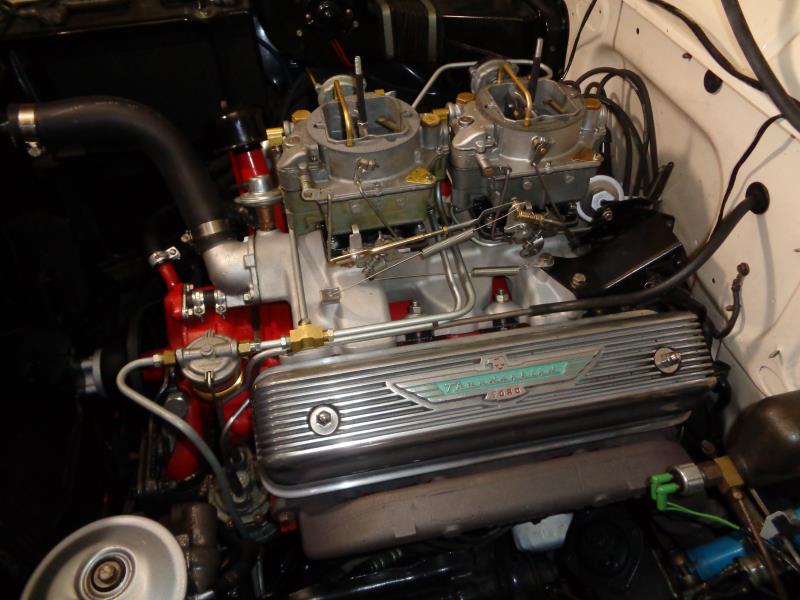
OH!
I see an EDEL fuel pump on yours. Test the fuel pressure. It may be too much for those carbs.
|
|
By Joe D - 7 Years Ago
|
|
JDC,
Both carbs are supplying idle fuel now and as of yesterday afternoon both are operating together with the throttle linkage. I just had to move a stopper back on the linkage. It ran fine after changing this but still stalling after its up to temp.
Thanks,
Joe D
|
|
By Joe D - 7 Years Ago
|
Kultulz,
I didn't realize carbs were calibrated when they were rebuilt. I thought you just adjusted the mix screws and the idle screw and away you go. I will ask about that. Thanks.
The carbs have no choke plates at all. They were removed.
I have a Tach installed on my dash.
Using port off of the rear carb but also tried manifold port (14" vacuum) and also plugging all three. I did not seem to notice any difference in performance after trying these combinations.
Edlel fuel pump is rated at 5 psi. and worked fine for about 2 years. Could be famous last words right!
I'm going to install a clear fuel filter before the carbs to see what happens after a stall. It seems to be starving for fuel and not flooding. I have never smelled a lot of gas nor have I noticed any black smoke out of the exhaust when re starting which would indicate flooding.
Thanks for your help!
Joe D
|
|
By Joe D - 7 Years Ago
|
[quote]Joe D (12/19/2018)
Kultulz, I didn't realize carbs were calibrated when they were rebuilt. I thought you just adjusted the mix screws and the idle screw and away you go. I will ask about that. Thanks. The carbs have no choke plates at all. They were removed. I have a Tach installed on my dash. Using port off of the rear carb but also tried manifold port (14" vacuum) and also plugging all three. I did not seem to notice any difference in performance after trying these combinations. Edlel fuel pump is rated at 5 psi. and worked fine for about 2 years. Could be famous last words right! I'm going to install a clear fuel filter before the carbs to see what happens after a stall. It seems to be starving for fuel and not flooding. I have never smelled a lot of gas nor have I noticed any black smoke out of the exhaust when re starting which would indicate flooding. Thanks for your help! Joe D
|
|
By KULTULZ - 7 Years Ago
|
|
Mix screws backed out two turns. tried to adjust but really didn't seem to change how it idled. Carbs are synched at idle.
Manifold vacuum reading 14 " at 1000RPM.
Drove to work this morning and stalled coming off of highway and I could not keep it idling without goosing the accelerator. Before carbs were rebuilt it seemed to recover after a couple of minutes of goosing and idling.
OK, let's start again.
When the truck de-accelerates, it shuts off? Is this in gear or out of gear (between gears)? Does it stall straight ahead or on a turn? Re-start easily?
Your manifold vacuum is 14HG and steady? Right now, where is your source of DIST vacuum advance?
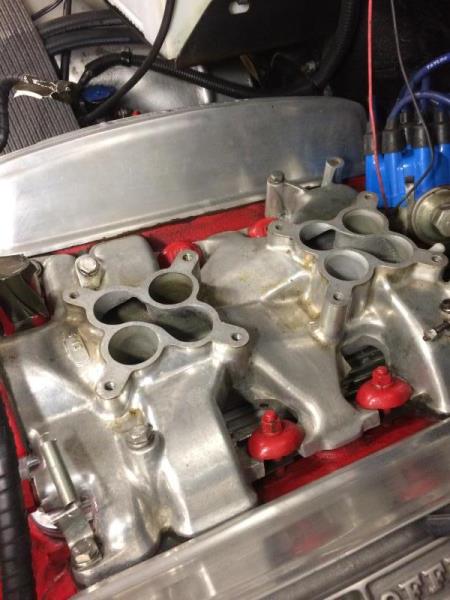
If you adjust the mixture screws without any change, there is going to be an internal carb problem. The style of carb the builder chose to use are both Primary. Both will have idle circuits. If you want both to open in unison, all you are doing is wasting gasoline on a street engine (again IMO). It will be difficult to trace a carb problem with two working together.
Now does it ever idle erratically or the TACH reads incorrectly?
No chokes?
|
|
By Joe D - 7 Years Ago
|
Kultultz,
When on the highway and coming to a light or exit and trans is placed in neutral engine dies. You can watch the tach drop to zero rapidly.
If left in gear as long as possible when coming to a stop and then goosing the accelerator, I can keep it running and eventually it recovers and runs good until its placed in neutral again.
Straight ahead driving but it does it while turning as well.
It does not happen until engine is up to around 180 degrees. When placed in neutral at lower temperatures it hold 1000 rpm steady.
It restarts fairly easy with no gas smells or black smoke or backfires.
Distributor vacuum advance is hooked up to the rear carb port.
It does idle erratically after stalling but recovers after a few minutes.
Tach reads fine.
No Chokes. Its a pain for a few minutes but warms up pretty quickly.
Thanks for the help!
Joe D
|
|
By Joe D - 7 Years Ago
|
Oh one more thing! I hooked up a clear fuel filter at the inlet of the carbs. After the truck stalled I checked the filter without trying to restart. The filter remained full of gasoline so that should eliminate any fuel starving issues.
Thanks again!
Joe D
|
|
By KULTULZ - 7 Years Ago
|
|
Distributor vacuum advance is hooked up to the rear carb port.
When you say carb port, are you referring to a port on the carb body or the nipple in the intake manifold plenum I tried to show on the photo?
If on carb, any outlet above the throttle plates is ported and below throttle plates is manifold vacuum.
What I am thinking is that with the high idle and 14HG manifold vacuum @ idle is that the initial timing is retarded. If connected to manifold vacuum, the vacuum advance feature will go full advance giving the high curb idle RPM. Someone may have tried to correct this by mis-adjusting the throttle plates.
This is why identification of the carb(s) is important to choose the correct kit and make adjustments such as throttle plates.
Also, ensure proper operation of DIST breaker plates with either a vacuum pump or a hose and sucking. Confirm that the upper plate moves easily when vacuum is applied, the canister holds vacuum and a fast and smooth return when vacuum source is ended.
If using full manifold vacuum on an advance, when the throttle plates are suddenly closed, a full manifold signal is sent to the DIST advance and may cause stalling. That was one of the purposes of the dual diaphragm on the 56 LOAD-O-MATIC.
Other than this, the only thing I can think of is a dash-pot to prevent the throttle blades from snapping shut.
And of course, the idle mixture screws not responding. It sounds like the guy just threw a kit(s) into them and called it a day. Why CARTER didn't ID their carbs with stamping like HOLLEY is beyond me.
|
|
By KULTULZ - 7 Years Ago
|

|
|
By KULTULZ - 7 Years Ago
|

|
|
By KULTULZ - 7 Years Ago
|
Sorry about the multiple posts but I have difficulty with this forum format.
The above excerpts are pertaining to the 56 MERC WCFB 2361S and SA. Whether it pertains to any other year or manufacturer usage (GM - CHRY) I have no idea. But this info is what a quality re-builder should know.
I don't know if they are the source of the problem(s) but just posted the info for anyone in the future that may come across and need it.
EDIT- Trying to master the KING'S ENGLISH
|
|
By Joe D - 7 Years Ago
|
Kultultz,
The vacuum line from the distributor is hook up to the rear carb port. This port down low on the front of the carb. Like I mentioned before, no matter what I do with the distributor vacuum hose it really does not effect engine performance and stalling issue.
Anyway a friend of mine has a computer box that runs the engine ignition and you can observe while driving what the vehicle is doing and see exactly what happens during a stalling event. He thinks there is some sort of ignition problem and would at least like to rule this out before trying other things.
I will keep you and any other interested Y-blockers updated.
Thanks for your help!
Joe D (The Frig)
|
|
By Ted - 7 Years Ago
|
|
Distributor vacuum advance chamber working?
|
|
By KULTULZ - 7 Years Ago
|
|
... a friend of mine has a computer box that runs the engine ignition and you can observe while driving what the vehicle is doing and see exactly what happens during a stalling event. He thinks there is some sort of ignition problem and would at least like to rule this out before trying other things.
COPY!
Get me some info on that box he is talking about. Got me curious.
Years ago ... (yeah, I know) ,,, there was a spark tester that had a long lead and suction cup that you stuck to the WS and drove to see if the IGN was cutting out.
|
|
By Joe D - 7 Years Ago
|
Ted,
I had the cap off and pulled a vacuum by sucking on the hose attached to the distributor vacuum diaphragm. The plate moved smoothly and the diaphragm held vacuum. As vacuum was released it returned to its original position.
I have Pertronix electronic points and a pPertronix matching coil. Have you ever heard of a issue like this with these?
The mechanic who is helping me said he saw them fail but the engine would not re start like mine does.
Thanks for your help!
Joe D
|
|
By Sandbird - 7 Years Ago
|
By any chance has anyone installed a PCV system on your engine? The reason I ask is in a photo on page 10 it looks like there is a hole drilled in the back of the manifold that doesn't belong there.
with only the back carburetor supplying idle fuel that could be leaning out one of the idle ports leaving only one to supply fuel, if that. This was edited to correct spelling and add the last sentence.. It could be the source of the lean condition others suggested.
|
|
By KULTULZ - 7 Years Ago
|
|
Sandberg Posted-
By any chance has anyone installed a PCV system on your engine? The reason I ask is in a photo on page 10 it looks like there is a hole drilled in the back of the manifold that doesn't belong there.
with only the back carburetor supplying idle fuel that could be leaning out one of the idle ports leaving only one to supply fuel, if that.
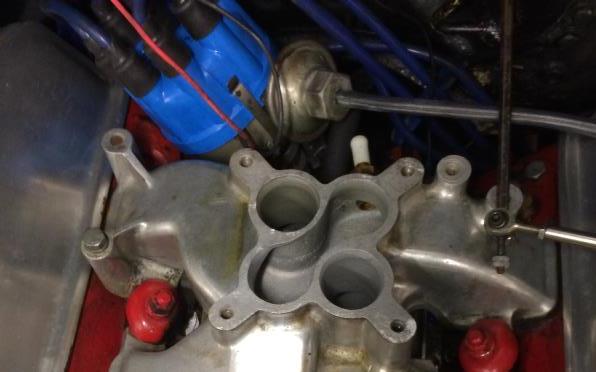
GOOD POINT!
I had asked earlier if it was the VAC ADV SOURCE but got no replay.
|
|
By KULTULZ - 7 Years Ago
|
|
The vacuum line from the distributor is hook up to the rear carb port. This port down low on the front of the carb. Like I mentioned before, no matter what I do with the distributor vacuum hose it really does not effect engine performance and stalling issue.
Exactly what/where is the vacuum source for the DIST? Where does that long VAC ADV signal hose shown on the above photo go?
If the advance is direct manifold source, it will cause the high RPM curb idle and most likely the engine cutting off when the accelerator is completely released.
As for the PERTRONIX, there has been difficulty with the IGNITOR I, especially when coupled to an electronic TACH. That may be the source as it does not happen until normal operating temp is reached.
|
|
By Sandbird - 7 Years Ago
|
|
Awful big hole for distributor vacuum. The original e setup took ported advance vacuum from the teapot carburetors. they didn't use manifold for advance. Kuhl, I didn't realize you pointed this out, each time I read this thread I get more confused. Right about now I would throw a 2 barrel w/ manifold on it and see what happens.
|
|
By KULTULZ - 7 Years Ago
|
|
Awful big hole for distributor vacuum. The original e setup took ported advance vacuum from the teapot carburetors. they didn't use manifold for advance.
Yes it is, but who knows who and how assembled the setup? Have no idea of carb source. Someone kitted them but without knowing the carb source how did he set them up? Just kitting one isn't going to solve many problems.
|
|
By KULTULZ - 7 Years Ago
|
Here is a thread discussing how gasoline was filtered before the inlet filter in the tank was used -
https://www.ford-trucks.com/forums/1566233-fuel-pump-questions.html
|
|
By Joe D - 6 Years Ago
|
KultulZ and Sandbird,
The computer box I mentioned was not a computer at all. It takes the place of the engine's ignition system for emergency road breakdowns. We tried this on sunday but the truck started to cross fire and sputter so we unhooked.
There is no PCV system on the engine, just a breather cap and hose on back of manifold.
Where is the hole in the manifold your see? There is one in the picture inside the rear carb location which goes to a port (14" vacuum) that is capped with a white cap.
The distributor vacuum advance is hooked up to the rear carb port. This port has no vacuum at 1000rpm idle but as you accelerate it does jump up (vacuum Gage). I was told this normal.
I did try to test drive with tach disconnected and engine still stalled.
Other things I tried were: Hooked up a pressure gage on fuel line before carbs and it held 7 lbs. the whole time driving and stalling.
Tried setting idle up to 1200 rpm. Still stalled.
Replaced intake manifold gaskets because #1 cylinder is running about 150F hotter than #2. We thought there was a leak causing this but still stalled and temperature difference remains.
Thanks for all your help! I'm not sure what to check next.
Joe D
|
|
By charliemccraney - 6 Years Ago
|
|
Where does the hose on the back of the manifold go?
|
|
By Sandbird - 6 Years Ago
|
|
The hole seems to be the one you speak of with the white cap. To add some credibility to my concern I own a '57 E Bird and factoring in old age idiocy I walked out to my garage and rechecked the manifold. The factory did not put a hole in the back of the manifold. I am also curious where the hose that Charlie asked about goes to. The teapots had a port in their bases to access manifold vacuum which was used for power brakes and input to the fuel pump vacuum booster. I had a similar problem with high idle and that was when I discovered they used larger clam shell washers on E manifolds that took a bigger bite of the aluminum flanges. I don't recall if you told what the initial timing is. I know it would be a band aid but a dash pot installed on one of your carbs might make your truck more driveable until you find the answer.
|
|
By miker - 6 Years Ago
|
“There is no PCV system on the engine, just a breather cap and hose on back of manifold“
As Charlie asked, where does the hose go. If you’ve got a hose on the back of the manifold, not the road draft connection in the valley pan, you’ve got a pretty good vacumn leak. Engine warms up, choke goes off, you're way lean. I’ve been following this, but didn’t have anything to offer until I saw that post, if it was covered earlier, my apologies.
|
|
By Joe D - 6 Years Ago
|
|
The hole in the manifold (rear carb location) has a fitting that is capped with a whit cap. This is where I tested for vacuum and it showed 14" of vac at 1000 RPM.
The distributor vacuum advance is hooked up to the rear carb port (down low on body of carb).
There is a vent hose on the back of the valley pan that runs down to the cross member to keep it lubricated!! No PCV valve.
After hearing about how a dash pot works I agree that it would prevent the stalling because I can keep the engine running most of the time by keeping trans in gear or keeping foot on accelerator however a extra foot would be nice!
Thanks for your help!
Joe D
|
|
By Joe D - 6 Years Ago
|
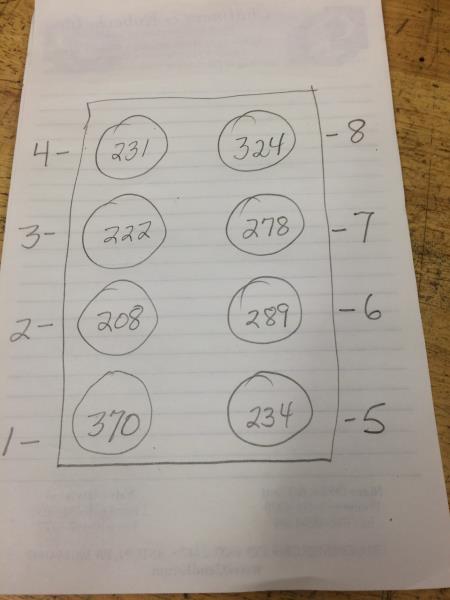
|
|
By Joe D - 6 Years Ago
|
I replaced the intake manifold gaskets the other day because of the temp difference between number one cylinder and the others. We though a leak was causing a lean condition inside cylinder driving temp up.
Did not solve stalling issue!
Does anyone live near Philly and make house calls? LOL
Joe D
|
|
By charliemccraney - 6 Years Ago
|
The temperatures do indicate a problem. They don't necessarily mean much for your current issue unless the temperatures were known before the stalling started to happen.
A common issue has been the high idle. Getting that fixed might make this stalling issue easier to fix. It could even be the problem and just was not bad enough until recently.
For clarification, the hose on the back of the manifold is actually the hose on the back of the valley pan?
|
|
By Joe D - 6 Years Ago
|
Thanks Charlie, I agree!
The manifold port in the picture on page 10 is capped with a white cap. No Hose.
Valley pan (crankcase vent) is connected to a hose that I ran down the the frame some years ago.
Thanks for your help!
Joe D (The Frig)
|
|
By Sandbird - 6 Years Ago
|
|
14" manifold vacuum seems kind of low. Did you ever do a compression test and check the initial timing? Just re-read an earlier post and see where you advanced the timing a few more degrees above 4 degrees. It would be interesting to see what the compression is .
|
|
By DryLakesRacer - 6 Years Ago
|
Since my WCFB set up is the other one in photos and there are similarities there are definately differences too. The Merc WCFBs were set up for Loadmatic distributors and mine are for Oldsmobiles which are not. Ted made changes to the Holley's to let them run with 57 up distributors but I don't know anyone making the changes to the WCFB which may be needed.
My fuel pump pressure is 4 psi and in my opinion 7 psi is too high for any engine. My sons and my 2 race cars run all modern carbs and setup with over 600HP and are settings are 5 psi with large feed lines. I'm not sure these carbs with long arms on the their floats should have such pressure; newer carbs have very short to almost no float arms The longer arms have quite a bit of leverage. The metering rods are also pretty sensitive and I've worked with mine and their settings and I can assure you I have no stalling when warm or even coming off a run up to 90- 100 mph which I do every month the flow some fuel thru all the jets and clean out the fuel bowls. Wish I had some suggestions.They only thing is if you get too frustrated and want to remove them, go to a Blue Thunder type high rise and a Summit carb...
|
|
By Joe D - 6 Years Ago
|
|
The timing is advanced to 28 degrees. This seems to be the sweet spot for engine performance. I have tried retarding the timing and advancing it more but the engine still stalled after up to temp and placing in neutral.
I have the stock fuel pump so I will reinstall and see if that helps. Most people have said that 7 psi is fine but like you said with the old carbs might not like the higher pressure. I believe the shop manual says fuel pressure should be 3-4 psi.
I will do a compression test. Could a valve, intake or exhaust cause a high temp difference like is shown in the above photo?
Thanks,
Joe D
|
|
By Sandbird - 6 Years Ago
|
|
Wow 28 deg's is a lot of initial advance. I would think a bad valve would be more apt to create a miss. Maybe a compression check will show something. There has to be a reason for the low vacuum reading some where. By now I am having a problem remembering what has and hasn't been done. I did remember about 50 years ago a guy pieced together a y-block that had the heads shaved and something got screwed up that the intake had a slight misalignment of the manifold with the ports on the head that leaked. Did the bolts go in easy when you changed the intake gaskets?
|
|
By Joe D - 6 Years Ago
|
Sandbird,
The bolts went in fine and I cleaned up all the surfaces for the gaskets.
I installed the stock fuel pump last nite with a pressure gage on pump discharge. I did not test drive yet just idle to see what pressure was. It was between 5.5 and 6 pounds. The EDEL fuel pump pressure was 7 psi right before carbs. Doesn't seem like it would make that much of a difference but who knows.
I will report back after the test drive this weekend.
Thanks!
Joe D (The Frig)
|
|
By KULTULZ - 6 Years Ago
|
|
The timing is advanced to 28 degrees. This seems to be the sweet spot for engine performance. I have tried retarding the timing and advancing it more but the engine still stalled after up to temp and placing in neutral.
Are you saying you have initial timing set @ 28 degrees BTDC with no vacuum advance attached? And it runs? When you put the vacuum gauge on the intake vacuum source, did the needle show a steady 14HG? If so, there is something wrong with the IGN timing.
I have the stock fuel pump so I will reinstall and see if that helps. Most people have said that 7 psi is fine but like you said with the old carbs might not like the higher pressure. I believe the shop manual says fuel pressure should be 3-4 psi.
You may have to bring that down with a pressure regulator.
Also, you are going to have to get the crankcase ventilation corrected. That rubber hose trick does not work. There is a special E-CODE valley pan to be used under that particular intake and it will accept a road draft tube. The bottom of the intake manifold plenum will be damaged w/o the correct valley pan.
|
|
By Ted - 6 Years Ago
|
|
Joe D (1/3/2019)
The timing is advanced to 28 degrees. This seems to be the sweet spot for engine performance. I have tried retarding the timing and advancing it more but the engine still stalled after up to temp and placing in neutral.
When I see initial timing degrees set that high, I question if the damper ring has slipped thus throwing off the timing marks. That's assuming the idle is not too high and/or the distributor advance springs have been changed to the very 'weak' ones.
|
|
By KULTULZ - 6 Years Ago
|
|
When I see initial timing degrees set that high, I question if the damper ring has slipped thus throwing off the timing marks. That's assuming the idle is not too high and/or the distributor advance springs have been changed to the very 'weak' ones.
He said I believe (it's getting so long) that he couldn't get curb idle below 1000 RPM.
|
|
By KULTULZ - 6 Years Ago
|
OK, this was an earlier post-
No date recorded as per format.
Ok tonight I drove the truck and it took awhile to make it stall because it was cool outside (52 degrees). After getting it to stall I pulled off the side of the road and checked the carbs:
I look into the carbs and saw some cloudy vapors. When I pulled back on the throttle gas did squirt in the back carb and then the front carb. I also checked the exhaust and it didn't smell like gas.
I'm going to get a tank full of ethanol free gas and see what happens. Stay tuned!
OK. ONE of the problem(s) must be fuel percolation or too high a fuel pressure over riding the needle/seat.
Again, having that fuel supply lined plumbed as is puts it directly at the engine coolant crossover, upper and heater hoses. Add prop wash to this from the radiator and you have excessive fuel temp. Line insulation isn't going to control it, especially with ethanol blended fuel. There is also no inlet fuel filter. The pump pre-filter is only 100 micron and will not stop fine trash.
The possible 2nd problem is with the timing as mentioned in above posts.
While I am here, and after scanning through this thread, I noticed the oil fill tube with no cap?

|
|
By Sandbird - 6 Years Ago
|
|
You may be losing some vacuum through your unused choke thermostat assemblies. A photo on page 5 shows the unused choke has the hot air input tubing cut off and crimped close. There is a passage in the carb that goes from the choke to manifold vacuum.
|
|
By Joe D - 6 Years Ago
|
Kultulz,
The timing is 28 BTDC with vac adv hooked up to rear carb port.
Intake shows a steady 14"HG
I tried stock fuel pump (6 pounds) this weekend and engine still stalled.
I do not understand what you are saying about the crankcase vent and special valley pan? The truck ran fine for 2 years. I just hooked up a hose to the fitting to route oil mist away from the back of the engine.
Ted,
The Idle can not be turned down below 1000rpm. I talked to the shop who just did the rebuilds and they said that they could calibrate to try and correct this issue. We could not ID the Carters. The guy said they were 450-500 CFM carbs based on the size of the throats and they worked fine.
I'm going to try getting an adaptor for my Edel manifold to accept a single carb. I'm not sure if there is such a thing? Or I'm going to purchase a single carb 4 BBL manifold before I send the old Carters WCFB's back to California for calibration.
Kultulz,
I don't believe its fuel percolation but would like to try some racing fuel in 5 buckets sometime, its just a little pricy.
There is an oil fill tube cap. It's brushed chrome and a little hard to see.
Sandbird,
That's not my engine on page 5. Both of my chokes have been removed and the vacuum holes are plugged.
Thanks Fellow Y- blockers for your help!
Joe D (The Frig)
|
|
By Sandbird - 6 Years Ago
|
Joe D,
I realize that wasn't your engine, Page 10 has a picture of what I thought was your engine and the chokes look like they're not plugged. I thought the image on page 5 would show that others saw fit to block the unused choke(s) off. I guess the dark shadows fooled me. I've read teachings that claim a lean mixture burns slow which makes the engine need more advance than usual. My thoughts are the low 14" vacuum reading is too low to pull enough fuel through the idle circuits. I asked about a compression reading to see if it is normal, if it isn't your timing chain may have jumped time or your engine may just be tired. These thoughts are depending on that there are no vacuum leaks and your carbs are perfect. If you have good compression I would go forward with trying a different carb and manifold.
|
|
By charliemccraney - 6 Years Ago
|
|
A high idle that cannot seem to be solved is not running fine. There is something wrong which is causing that. The only way it can idle too high is by getting too much air. There is either a vacuum leak or the throttle plates are not closing for some reason.
|
|
By KULTULZ - 6 Years Ago
|
|
Kultulz,
The timing is 28 BTDC with vac adv hooked up to rear carb port.
Intake shows a steady 14"HG
I tried stock fuel pump (6 pounds) this weekend and engine still stalled.
I do not understand what you are saying about the crankcase vent and special valley pan? The truck ran fine for 2 years. I just hooked up a hose to the fitting to route oil mist away from the back of the engine.
I am a$$-u-me(ing) it is showing 28 BTDC (with vacuum signal included) as a result of heightened curb speed idle and as a result supplying a PORTED VACUUM SIGNAL to the DIST.
The HIGH CURB IDLE may be as a result of the secondary throttle blades not being adjusted correctly. I would not send them back off as the re-builder has no clue as he did not check this adjustment on re-kitting.
Your oil fill cap. Is it vented or closed to the atmosphere?
Heightened fuel pressure may cause an enriched fuel mixture. There is no FORD data that I know of other than LINC-MERC regarding CARTER WCFB. You may have to research scrub 283 Dual Carters of the period for recommended fuel pressure.
|
|
By Joe D - 6 Years Ago
|
Thanks Y Blockers!! We will correct this issue soon! A friend of mine told me when I first bought this old hot rod and was having trouble with the points, to "remember it's all about the journey".
Kultulz
The oil fill cap is vented and I put a sock around the vent holes to catch the oil mist.
Yesterday I ordered a stock cast iron manifold (single 4 BBL) and a friend at work is giving me a Edel carburetor. I really believe it's the throttle plates not closing all the way and creating a lean condition (not flooding). This explains why the idle screws are all the way backed out and it idles at 1000 RPM. Engine runs strong and always starts back up and recovers.
We will know for sure if its the carbs once I test drive with the single carb set up.
Anyone out there know someone who can calibrate these Carter WCFB's?
Thanks,
Joe D (The Frig)
|
|
By KULTULZ - 6 Years Ago
|
|
Anyone out there know someone who can calibrate these Carter WCFB's?
Well, actually you can as it needs to be done and then run to make sure everything is correct.
Is your E-MAIL address shown here?
|
|
By KULTULZ - 6 Years Ago
|
|
I do not understand what you are saying about the crankcase vent and special valley pan? The truck ran fine for 2 years. I just hooked up a hose to the fitting to route oil mist away from the back of the engine.
Ok, let me see if I can explain this correctly -
The 1957 8V intake had an increased plenum area for better breathing. The carb pad casting couldn't be raised as it also had to fit under the hood of the 57 BIRD. So it was cast with a deeper plenum. A special valley cover with relief was used to allow for the increased depth. Without it, the manifold plenum bottom would overheat damaging the bottom side of the intake.
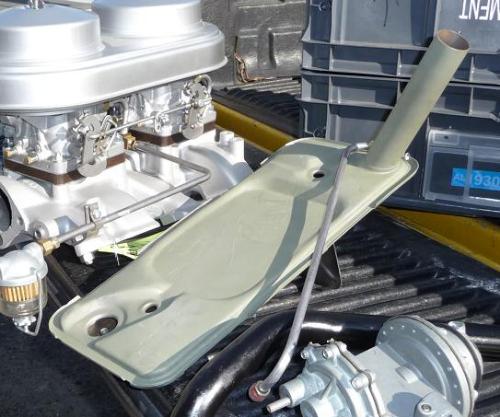
Does yours have this valley pan? Also, the 1957 E-CODE used a road draft tube off the rear of the pan.
|
|
By Joe D - 6 Years Ago
|
Kultutz,
I'm going to remove the carbs and manifold this weekend and prep for the stock manifold and single carb which I should have next week.
I will remove the valley cover and send pictures. The guy who did the rebuild on the truck said everything was stock when I asked him about the cam. He also said that he believed it was the original 292 Y-Block in the truck. !960.
My e mail address is jderita@comcast.net
Thanks again!
Joe D
|
|
By charliemccraney - 6 Years Ago
|
If he used the word believe, then you don't really have any idea what is going on. Belief is a lot different than knowledge. It doesn't necessarily mean anything bad but basically anything said by him should be discarded until evidence supports it. The 2-4s absolutely is not stock in 1960 on any Y-Block. So there goes his everything is stock claim.
You don't need to remove the valley pan. I would not advise that unless you have a problem with it or you do need a different one for the 2-4 intake. Compare it to kultulz picture or just post a picture of it installed. The difference will be obvious.
|
|
By Joe D - 6 Years Ago
|
Charlie,
I should have said that as far as the engine goes, when I asked him (previous owner) about the cam he said everything with the engine rebuild was stock.
I learned through this site and while trying to find a kit for the Carter WCFB's that lesson because he said the dual quads were off of a 57 T-Bird.
Well, they might have been taken off a 57 T-Bird but certainly were not stock OEM. I wish they were since I could have them calibrated to spec.
Thanks again,
Joe D (The Frig)
|
|
By DryLakesRacer - 6 Years Ago
|
As for WCFB tuning. I found both the 53 Cadillac and the 53 Oldsmobile ones I used worked perfect as built. I have no Idea from the other cars that used them.Their compression ratios were very close to the Ford and really that's what matters the most. I tried one size smaller jet in the Cadillac one and my 56 292 did not run as good and I went back. Metering rods are harder to come by and they would be good for very minor adjustments.
Ford did not run progressive which I do. I idle on both carbs but run 99% of the time only on the rear. I use a Edelbrock 257. I need to push the foot feed to the floor when starting the engine after a week of sitting to squirt both in front and back. At no other time do i even touch the foot feed to start. There is no soot in my exhaust pipes, I blame this on the gasoline today.
You need to remember that just because you have 1, 2, 3, or 4 carbs if the air fuel mixture is correct for each on as a single it will work on your engine and you can open it up IF the engine can take the air. I know you guys don't like comparing our engines to scrubbies but think of the 245 HP Corvette. Its's a STOCK 4 barrel engine of 220 HP with dual quads that's why I felt my 292 Ford would be just fine with dual stock WCFB's and I was right...maybe just lucky but right. good luck..
.I guarentee you nothing sounds better than opening up dual quads on a freeway at about 60 mph and seeing 90-100 mph come up on the speedo before you can even think about it.
|
|
By Joe D - 6 Years Ago
|
Thanks DryLakesRacer!
Someone earlier I this conversation had said it was better to have the throttle linkage direct for every day driving. I switched this from progressive and it does seem to come out of the hole better.
When I finally get this stalling issue resolved I will try it again because I too like that sound when the front carb kicks in. Oh, not at the speeds you mentioned that's for sure. When I approach 70 miles per hour (tach 3000rpm) the whole truck starts to vibrate and I'm worried about losing parts!
That why it's called the Frig!
Thanks,
Joe D
|
|
By charliemccraney - 6 Years Ago
|
|
It shouldn't vibrate at speed. That will be a mystery to solve once this one is complete. When things are in good shape, these old truck do better than you might expect at higher speeds, although at least basic suspension and braking upgrades should go along with it.
|
|
By Joe D - 6 Years Ago
|
Not only do dual quads sound cool but they look cool too!!

|
|
By DryLakesRacer - 6 Years Ago
|
|
To most this is probably unheard of after doing the work of add dual quads, but in the 5 years it's been on with the Cad/Olds and 2 Olds WCFB's I have never ever floored it from a stop. Even with the change to the CrusieO I've still never wanted to do it. I accelerate right with traffic and when it's not up to operating temp it does have a very, very slight stumble and I'm sure non progressive linkage would eliminate it. The passages in an Edelbrock in my opinion were done for racing and not the street but enough air/fuel mixture gets thru for normal driving and all my plugs read the same.....
|
|
By Joe D - 6 Years Ago
|
Removed the Edel manifold and dual quads. Also removed the valley cover. here is what it looks like.
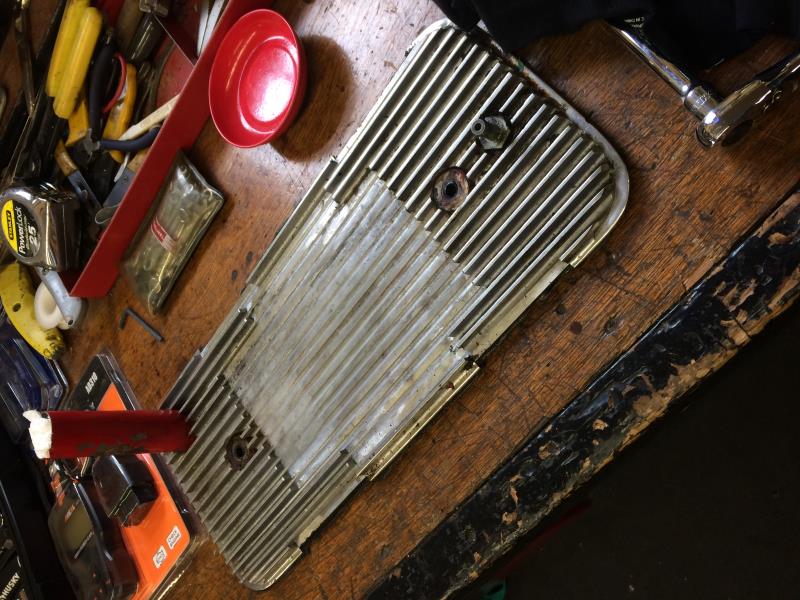   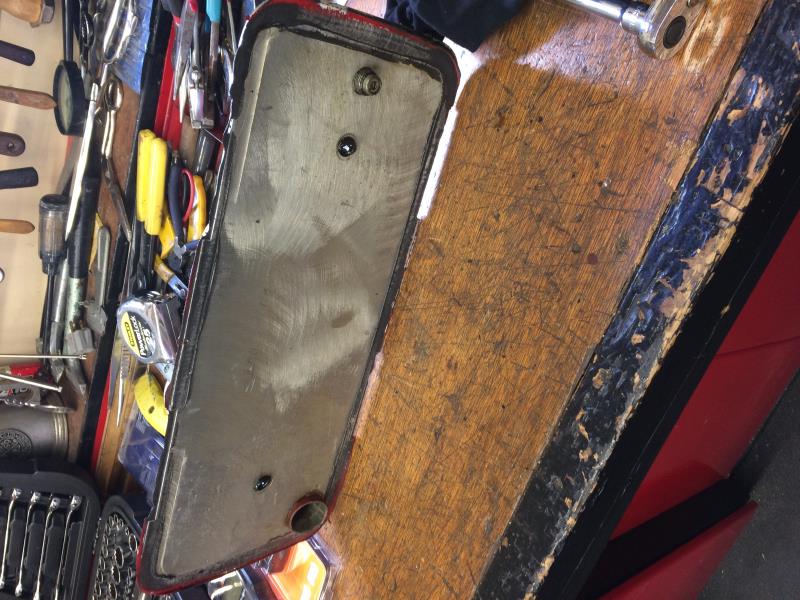 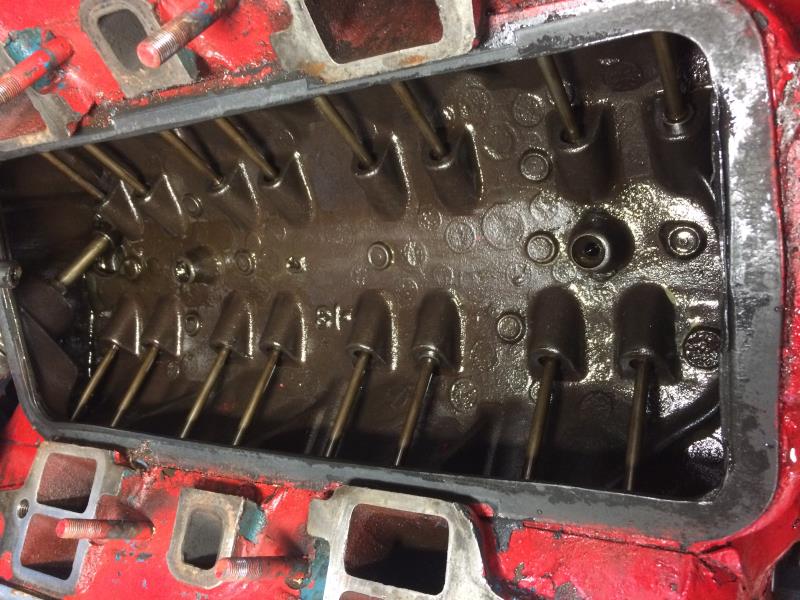
|
|
By Joe D - 6 Years Ago
|
Test fit stock manifold.
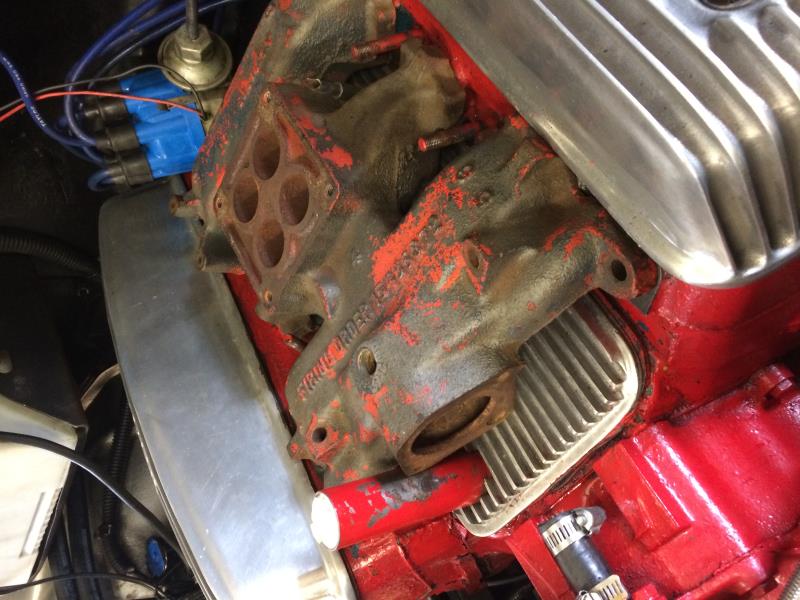
|
|
By Joe D - 6 Years Ago
|
Work update:
Removed Edel manifold and dual quad Carters.
Removed valley pan cover. See photos. Kultulz, ?
Test fit stock manifold.
Going to have stock manifold beed blasted and checked for cracks.
Going to try single carb to see if stalling issue is resolved.
|
|
By KULTULZ - 6 Years Ago
|
|
Removed Edel manifold and dual quad Carters.
You have a 1957 FORD E-CODE intake.
I see the milled ALUM valley pan. At least they took that into consideration.
: ... and then again the intake may have not set all the way down on the pan ... ... and then again the intake may have not set all the way down on the pan ...
|
|
By Joe D - 6 Years Ago
|
I test fitted the stock manifold. it was hitting the oil fill/ breather tube by the thermostat location. Ground down a little of the cast iron to clear it.
I guess the Edel manifold hit the fins on the valley pan thats why they ground them down.
Kultulz,
Is the valley ok without a plenum like you showed in the photo?
Thank,
Joe D
|
|
By KULTULZ - 6 Years Ago
|
|
I test fitted the stock manifold. it was hitting the oil fill/ breather tube by the thermostat location. Ground down a little of the cast iron to clear it.
I guess the Edel manifold hit the fins on the valley pan thats why they ground them down.
Kultulz,
Is the valley ok without a plenum like you showed in the photo?
Thank,
Joe D
Your CAST ALUM VALLEY PAN should work fine under the 4V ECZ-B intake manifold.
The problem(s) will be if it fits under the FORD 8V intake properly. If it hits the plenum bottom in any way, it may not seal properly and also cause heat damage.
|
|
By Ted - 6 Years Ago
|
I’m in agreement with you in putting a single four intake on the engine and determining what is going on with the carbs if indeed it is a carb issue. Besides using your two existing carbs on the engine, I’ll suggest putting a carb adapter on the intake and using some kind of known ‘good’ late model carb to get a base line.
It would be nice to know exactly what application your two WCFB carbs came from. In looking at the pictures in detail, I don’t see the spark advance control valve on the front of the carb which tends to point me to your carb(s) coming from an early Mopar application possibly.
You mention that this stalling issue is something that has showed up since purchasing the vehicle. If it ran good originally without the stalling issue, then something has obviously changed.
|
|
By Joe D - 6 Years Ago
|
Ted,
I'm getting an adaptor to try a Edelbrock or Holly carb. that I know works, on a single carb manifold. I'm thinking by now that its carburetion but who knows! I can even try one Carter at a time and that may tell us something as well.
We will see.
The truck ran good for two years with no stalling. It started in the spring (2019) and seemed to get worse during the summer months as temperatures rose.
I didn't change anything on the truck in the time before the stalling started.
I'm still not giving up on the Edelbrock manifold with the dual quad Carters since I spent money to have the carbs. rebuilt and I think they are old school cool.
I'll keep you guys updated. I really appreciate all the help!
Thanks,
Joe D (The Frig)
|
|
By Sandbird - 6 Years Ago
|
Joe D
I don't know if it's been mentioned yet, but I just remembered worn throttle shafts on the carburetors can cause idle problems.
|
|
By KULTULZ - 6 Years Ago
|
|
I don't know if it's been mentioned yet, but I just remembered worn throttle shafts on the carburetors can cause idle problems.
No it wasn't but a good point.
The vacuum gauge reads a steady 14HG (he reports) so it indicates no vacuum leak, only faulty IGN TIMING (again - IMO)
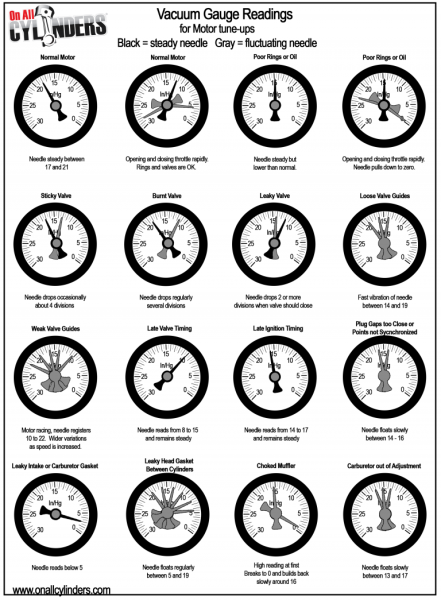
|
|
By Joe D - 6 Years Ago
|
Ok Y blockers,
I installed a manifold (1957 I was told above), carb adaptor plate and a single 4 bbl. carb. I did not have the chance to test drive but started it up yesterday.
It idled really smooth and I was able to turn the idle all the way down and it wasn't even warmed up yet!
I still have to hook up the electric choke and test drive to make sure this stalling issue is solved once and for all! Of course its freakin snowing in Philly and supposed to get worse this weekend. Oh well spring is just around the corner.
Updates will follow. Who thinks the stalling issue was resolved by removing the dual quad Carters?
Joe D (The Frig)
|
|
By charliemccraney - 6 Years Ago
|
The iron manifold you have provided pictures of is not 1957.
I don't know if the carbs or intake were causing the problem but they were clearly the cause of a problem if it idles properly now. You'll find out.
|
|
By Joe D - 6 Years Ago
|
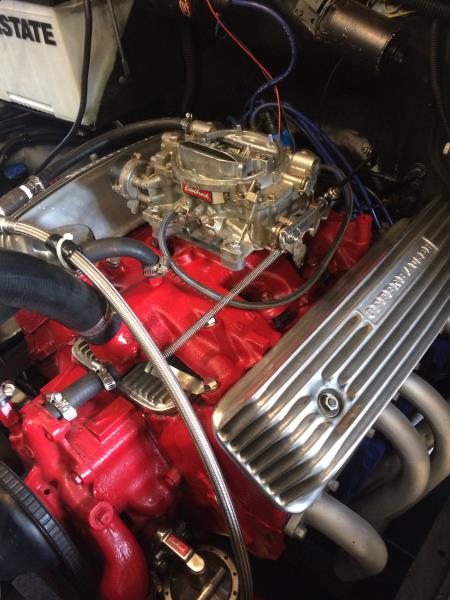

Thanks Charlie! Someone had said it was a 1957 E code manifold.
I agree it seemed to idle really sweet.
Joe D
|
|
By charliemccraney - 6 Years Ago
|
E-code is 2x4s. A '57 single 4 does not require an adapter for a modern carb.
|
|
By Ted - 6 Years Ago
|
Joe D (1/18/2019)
Thanks Charlie! Someone had said it was a 1957 E code manifold. I agree it seemed to idle really sweet. Joe D
Looks like a ECZ-A intake manifold which would be 1956. The ’55 manifolds had the automatic choke on the right side of the manifold while the ’56 manifolds had the automatic choke moved to the carburetor.
|
|
By Joe D - 6 Years Ago
|
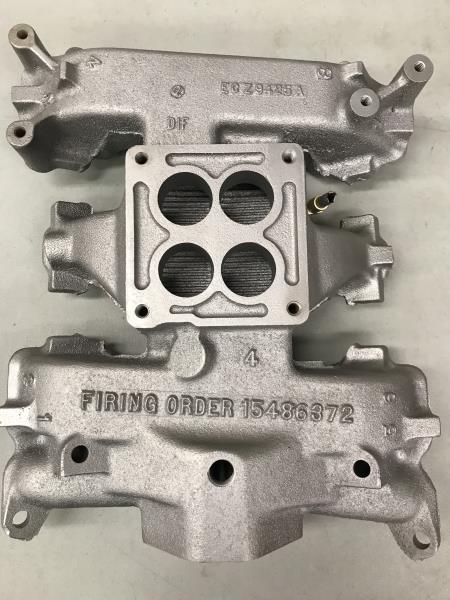
Thanks Ted!
Here it is. My buddy at work did a great job bead blasting it. I removed the exhaust tubing from center section and plugged the holes. The engine paint matched pretty close.
Joe D
|
|
By KULTULZ - 6 Years Ago
|
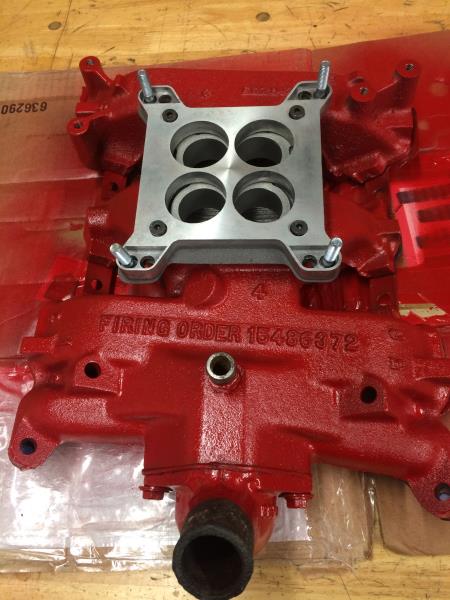
... woo ...
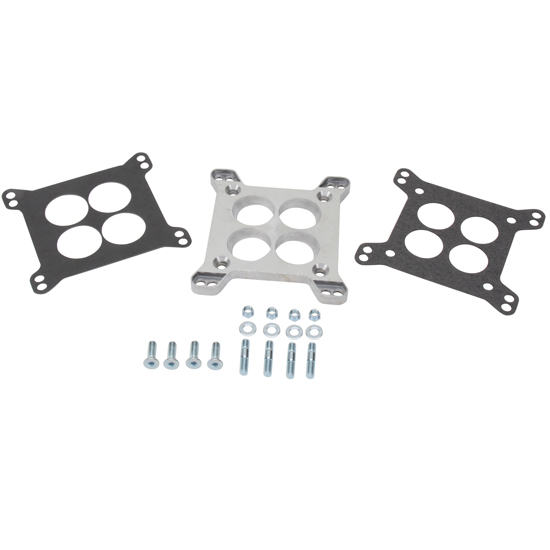
https://www.speedwaymotors.com/Holley-Edelbrock-to-Carter-WCFB-4-Barrel-Carburetor-Adapter-Plate,5551.html
|
|
By yalincoln - 6 Years Ago
|
|
hello! we had a similar problem with a friends e-bird that I rebuilt! it ran fine but would not idile down below 750rpm, and it would load up on fuel when shut off! unhooking one carb at a time made no differents and the idle screws were hard to adjust, like had a vacume leak, but none was found! we finally found it had a pin hole in one of the fuel bowl's and would only leak after it warmed up! I had a spare carb and that fixed the problem. now it idles fine and runs great!
|
|
By Joe D - 6 Years Ago
|
|
yalincoln,
Thanks sharing your story. I installed a single carb manifold and a newer Edlebrock carb. It seems that one of the WCFB's (I think the front carb) is out of calibration and pulling in too much air due to the throttle plates not closing off. I did start it last week with the new set up and it idled sweet and I was able to turn the idle all the way down. I have not had a chance to test drive to know for sure. Stay tuned for an update coming soon.
Joe D (The Frig)
|
|
By Joe D - 6 Years Ago
|
Well Y blockers here it is....
I test drove the truck yesterday and it still stalled! Not only did it stall like before with the dual quads but it was hard to restart from a dead stop. I could jump start easily by placing trans back in gear and popping clutch.
It seems like its not getting fuel so I reinstalled a glass filter near the carb to keep an eye on after stalling event.
Here we go again!
|
|
By Joe D - 6 Years Ago
|
|
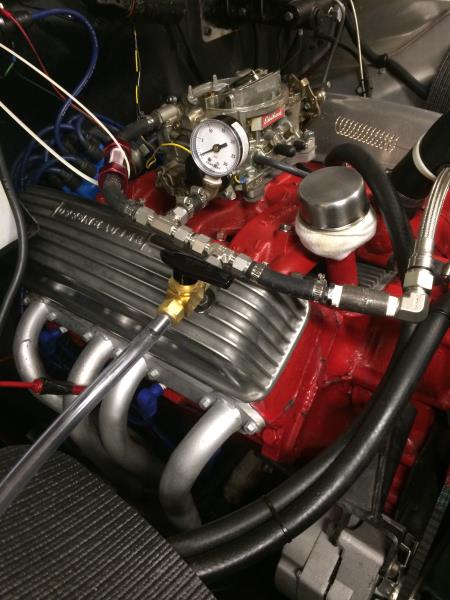
Temporary fuel line set up: Valve with clear tube to a bottle, Pressure gage and clear filter.
Fellow Y Blockers,
Stalling issue update:
Still stalling after engine is up to temperature (180-185).
Installed 1X4 manifold and 600CFM Edelbrock carb. I was able to set idle at 700rpm and can turn lower. With the Carters (2X4) I could not turn the idle down below 1000rpm. I though they were the problem but stalled the same.
Manifold Vacuum reading is 10.5"Hg.
Passed the fuel volume and fuel pump output tests.
After stalling event fuel pressure remains around 6.5psi right before carb and clear filter remains full of fuel. It does not seem to be flooding!
I'm going to remove the distributor and inspect clean and lubricate to ensure it's not sticking advanced (centrifugal). Also while its out install points and condenser and remove Pertronix electronic points. You never know at this point!
Going to also perform a compression test of each cylinder.
#1 cylinder header still reads more than 100 degrees higher than the others. Exhaust valve not opening or closing? I do not notice the engine missing.
Any help would be appreciated!
|
|
By KULTULZ - 6 Years Ago
|
|
Manifold Vacuum reading is ... 10.5"Hg.
After stalling event fuel pressure remains around 6.5psi right before carb and clear filter remains full of fuel. It does not seem to be flooding!
I'm going to remove the distributor and inspect clean and lubricate to ensure it's not sticking advanced (centrifugal). Also while its out install points and condenser and remove Pertronix electronic points.
The manifold vacuum is still way too low. You mentioned previously that you had trouble base timing the engine. IMO, you need to verify TDC with a piston stop and check the balancer markings
Good idea to check PERTRONIX with points replacement. The IGNITOR I can give problems.
It is now down to either fuel and/or timing. The carb may still being effected by poor fuel, either percolation, blend separation and/or vapor lock.
Is there a source of non-ethanol gasoline near you? Do you know what TOP TIER GASOLINE is?
What is with the sweat band around the oil fill tube?
|
|
By Joe D - 6 Years Ago
|
Kultulz,
I did locate TDC with my neighbor's finger in #1 cylinder and we marked pully. I did just purchase a timing light and will recheck this.
What is a piston stop? Just a indicator that lets you know when piston is at TDC?
I can get ethanol free gas from a landscaper supply house who has it in a 55 gallon drum. I could fill 5 gallon cans and transfer to my tank. I can also get 5 gallon cans of race fuel at a Sunoco station or local speed shop. I never heard of Top Tier Gasoline but I did hear of it referred to as Aviation Gasoline.
The tube sock around the oil fill tube/ breather is to keep the oil mist from blowing on my nice clean engine.
Thanks for your help,
|
|
By KULTULZ - 6 Years Ago
|
Watch This - https://www.youtube.com/watch?v=RENhHI9n65I
Trying to find true TDC with a finger or watching valve movement is akin to being somewhat close, as in horse shoes, hand grenades and thermo-nucleur warfare.
If you are misting from the oil fill cap, you have no crank-case ventilation or extreme blow-by.
|
|
By KULTULZ - 6 Years Ago
|
TOP TIER GASOLINE - https://www.toptiergas.com/
Bargain branded gasoline may/may not conform to standards or be imported.
What you need is a non-ethanol gasoline to see it is percolating/bend separation in the fuel bowl. That would eliminate fuel supply as a possible cause.
You don't need RACING FUEL - waste of money for your application. I am still concerned as to how the builder routed the supply fuel line(s) the way he did. Will absorb a lot of heat.
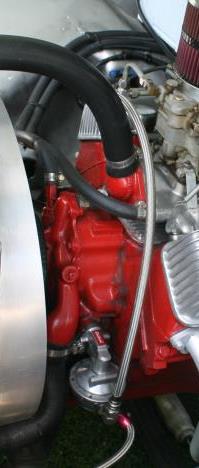
What would really help would be able to position the pressure gauge (outside of cab) to monitor while you drive. Be very careful here.
|
|
By Joe D - 6 Years Ago
|
Kultultz,
Thanks for the video and the Top Tier links!
The Sunoco fuel was on the list of Top Tier gasoline stations which I have always used (93 OCT) The only problem is in the Philly area it has 10% ethanol. I looked into finding ethanol free gas awhile back in the post and made some phone calls. The Landscape supplier and 5 Gallon cans of race fuel are my only ethanol free sources. I think this Top Tier gasoline is 99% marketing. It seems like all the stations are Top Tier. I worked as a gasoline blender for 12 years at the refinery in Philly. The only additive was a anti-corrosive and this was a very small amount added to the blend. Another thing I learned while working the blender is you get higher vapor pressure gasoline (a lot more butane and lighter hydrocarbons) in the winter. In the summer the vapor pressure is lower and not as much of these light hydrocarbons can be added. This is for pollution control (VOC's).
I did run a hose out the front of the truck with a gage attached to the end a shoved in my vent window. When the truck stalled the gage held a steady 6.5 psi. The clear filter before carbs was filled with fuel also. If the gasoline is boiling its inside the fuel bowls. Most of the problems I have read about this say this causes flooding and I don't think it's flooding.
Oh, and I did temporarily insulate the fuel lines running from the pump to the carb. Still stalled the same way.
|
|
By KULTULZ - 6 Years Ago
|
|
I did run a hose out the front of the truck with a gage attached to the end a shoved in my vent window. When the truck stalled the gage held a steady 6.5 psi. The clear filter before carbs was filled with fuel also. If the gasoline is boiling its inside the fuel bowls. Most of the problems I have read about this say this causes flooding and I don't think it's flooding.
All that showed was that the pressure held @ 6.5# between the pump check valve and needle/seat (or possibly excess pressure passed through the needle/seat until the float and float setting over-rode the pressure/volume increase if perc/separation was in the supply line) . If the perc/separation happened in the fuel bowl, the vapor will either exit via the bowl vent and/or enter the idle-power circuits, which will momentarily cause a rich condition in the throttle barrels possibly causing shutdown.
Oh, and I did temporarily insulate the fuel lines running from the pump to the carb. Still stalled the same way.
The fuel line runs along the engine to where it attaches to the pump. You have two heat sources just there, the heat absorption though the line and heat absorption via the pump housing which is bolted directly to a hot engine. Then the supply line is routed openly in fan wash and coolant hoses. It then runs to the carb via a steel line and then enters the carb which is all ready hot from engine heat. Think about it.
Again, E-10 has a much lower boiling point than straight gasoline.
It is going to be between fuel temp and timing IMO.
READ THIS - https://www.pure-gas.org/
|
|
By Joe D - 6 Years Ago
|
Y-Blockers,
I have not had the time to work much on this ongoing stalling issue but the next tests that I want to do are:
Adjust valves because an initial compression test on 1-2-3-4 cylinders was ugly. I hope its just a valve adjusting and not something major causing low compression and low vacuum reading, 10.5 "Hg, manual says it should be 18.
Perform a compression test, wet and dry
Verify TDC for #1 cylinder and mark. Check and adjust timing. Shop Manual says 10 degrees BTDC for 92 OCT
Pull distributor and inspect, clean and lube. Remove Pertronix electronic point and install OEM points and condenser.
Test drive truck with a can of ethanol free fuel, hose from can direct to the fuel pump. I don't think it's a fuel problem but I'm running out of stuff to check at this point!!
Any advice on the above tests would be appreciated.
Thanks for all your help Y-Block Heads!
|
|
By Joe-JDC - 6 Years Ago
|
|
Is your gas tank vented? Do you have a vented cap, or a line to atmosphere? If not, you are fighting a giant vacuum in the fuel system after it runs for a few minutes. Try another new cap. Have you actually been able to pull fuel from the tank into a container just prior to the carburetor? If you take the fuel line off before the fuel pump and take the gas cap off will fuel flow freely? Have you tried to blow pressurized air from the front back to the tank to see if the lines are clogged? Have you changed the fuel hose at every bulkhead from the tank to the fuel pump? Have you actually tried to let fuel drain from the tank into a pail for more than a dribble to see if it will slow down or stop on its own? Joe-JDC
|
|
By Joe D - 6 Years Ago
|
Joe JDC,
Gas tank has a vent and cap is not vented. I drove truck with pop up cap removed and it stalled the same.
Fuel does flow freely when line is removed from pump suction.
All new aluminum tank, braided SS hoses and high flow cartridge type fuel filter installed.
I have not let tank drain into a pail to see if it slowed after awhile. I'm going to run on a can of ethanol free gas from a can in bed of truck hooked up right to pump suction. This should eliminate fuel boiling issues and tank/ pump suction issues.
Fuel pressure is 6.5 psi and fuel volume test checked out good.
Thanks for your help!
|
|
By oldcarmark - 6 Years Ago
|
|
I have been following this Post. Very frustrating for sure. I don't remember seeing anywhere if You tried another Coil? Just a thought as at this Point it's hard to know what to try.
|
|
By Joe-JDC - 6 Years Ago
|
|
Then you have a wire that is grounding out the ignition when the transmission is shifted. Sure sounds like it is a wire that is hanging loose and can touch somewhere to ground. If the fuel changes didn't fix the problem, then it is electrical. Check all wires by gently pulling on them where they attach and check all the nuts for being snug on wire connections. Joe-JDC
|
|
By Joe D - 6 Years Ago
|
|
oldcarmark,
I did try a new coil with no luck and I also disconnected the tach because I heard this can cause stalling also.
Joe JDC,
I will check for loose wires and grounds.
Thanks for your help,
|
|
By oldcarmark - 6 Years Ago
|
|
Joe I have One more Suggestion to try. I was doing some reading online regarding similar Situations like yours. One Article I read was regarding a 66 Mustang which has same basic Start and Ignition Wiring etc as your Truck. Long and short of it was they figured it was the Starter Solenoid intermittently grounding out causing Voltage drop to the Ignition System. When it stalled restarting it reset the short in the Solenoid. There is a Wire from Solenoid to Coil which supplies 12 Volts for starting which is supposed to disconnect once the Car Starts.If the Solenoid acts up it can cause voltage from Coil to ground back through Solenoid. Worth a Try for very little Cost. For what my Opinion is Worth I think You have an Electrical Problem as nothing has improved after doing all that work on Fuel System.
|
|
By Joe D - 6 Years Ago
|
oldcarmark,
Hey its worth a try! How would I test to see if this is the problem? Maybe start the engine and then remove the wire from the coil that goes to the starter solenoid?
Thanks for the help!
|
|
By oldcarmark - 6 Years Ago
|
|
Yes or try another Solenoid. If You take it off and go for a Drive and it stalls. You will have to put the Wire terminal back on Solenoid so it will start. Worth a try.
|
|
By Rudder2fly - 6 Years Ago
|
|
Do you have a automatic trans neutral switch? I had a original s/w, neutral start, that would sometimes kick in the starter when motor was running.
|
|
By Joe D - 6 Years Ago
|
Gene,
My 1960 F-100 PU has a manual trans. "3 on the tree". I haven't had the time due to my work schedule but this week I'm going to start the test and checks mentioned above. I will keep everyone updated.
Thanks,
|
|
By Joe D - 6 Years Ago
|
Well here it is Y Blockers - I Test drove the truck yesterday and it did not stall!!
Here are the two issues resolved:
Rocker arms (valve lash) much too tight. I adjusted Valves cold and then hot (.019- .018) Can I make them a little tighter to quite them? Maybe .015?
I believe the valve lash was non existent on many of the rocker arms. Maybe someone tightened down on them at some point due to the tapping sound. I always thought they were hydraulic lifters until I did some online research and got the shop manual out. The compression test after the valve adjustment was greatly improved. All around 120-130 except #2 was 110. The first compression test was really ugly and when I removed the valve covers and saw the vanilla pudding inside the top of cover I thought I had a blown head gasket or worse. I was told this is normal for these engines because there is no PCV system. I did clean the oil fill/ breather and increase the size of the valley cover back vent fitting to help prevent this.
After adjusting valves and reinstalling spark plugs the engine would not start and the fuel pressure showed 0psi. I blew out all the lines with air and checked tank dip tube and tip over vent. All checked out fine. I then removed the fuel pump and was very puzzled because in shot fuel out as I pushed up and down on the pump arm. I then noticed that the arm was bent a little and had wear marks on the side of the arm. It looked like it was sliding off of the cam lobe. I could tell this was happening because when trying to reinstall the arm kept slipping off the front side of the lobe. I placed the pump in a vice and bent the arm towards the engine about 3/8". Reinstalled and engine fired right up!!
I'm not sure if the fuel pump arm issue was causing all the stalling problems or the valve lash being nil. Who knows? While test driving and right after I noticed the engine temp only got up to 175 degrees. It usually runs around 185 -190.
Also I placed my new vacuum gage on and it read 20" Hg!! It was around 14". Thanks Kultultz!
The checked the header temperature from #1 cylinder and it read only about 60-70 degrees higher than #2. Before #1 was 150-160 degrees hotter than #2.
Set the idle at 750. It seems happy there for now. Still have to adjust carb mix screws and play with timing.
Thanks for all your help! Y Blocks Forever!!
|
|
By KULTULZ - 6 Years Ago
|
CONGRATULATIONS!
So the valve adj was so far off it held poor engine vacuum? As for clearance, you want to stay within factory settings unless the valve-train has been modified in some way. You might want to check the condition of the rocker arms pads and valve stems for damage.
So this was done with not adding regular fuel? The engine heat may have been too much for the ethanol and now that problem seems to be solved. Interesting about the fuel pump arm being bent.
...when I removed the valve covers and saw the vanilla pudding inside the top of cover I thought I had a blown head gasket or worse. I was told this is normal for these engines because there is no PCV system. I did clean the oil fill/ breather and increase the size of the valley cover back vent fitting to help prevent this.
Listen as we have all ready covered this. The way you have the vent system is making it ineffective. There is no ventilation. You need to either add the correct road draft tube or go to PCV as either will ensure a much longer engine life.
|
|
By Joe D - 6 Years Ago
|
Kultultz,
Thanks! I have some questions from your post.
How do I check for rocker arm and valve stem damage.?I didn't see anything obvious.
I never added regular fuel (ethanol free). I have always used Sunoco 93 OCT. This was on the list though.
How would I add a draft tube or a PCV system? Which do you recommend?
Thanks again for your help!
|
|
By charliemccraney - 6 Years Ago
|
You can alter the valve lash by a couple thousandths in either direction as a tuning or comfort aid but you don't want to vary it too much - learn to love the sound of solid lifters. If they are factory rockers that have not been refurbished, wear will prevent accurately setting the lash with feeler a gauge, in which case, this method is best to use: http://www.y-blocksforever.com/tech/html/valvelash.html
For a quick check of the rocker arms, give them a twist side to side. If you can detect any movement, then they are probably worn. You can also loosen the adjusters and use a mirror to take a look at the valve contact pad. Sometimes you can slide all but the end rockers away from the pushrod and flip it most of the way around to see without a mirror. If signs of wear are found, the only way to truly evaluate is to disassemble the shafts for measurements.
I don't think there is a way to check valve stems without disassembling the heads. The compression numbers are low. A compression test needs to be done with the throttle held wide open. Did you do that? If not, then that will explain the low numbers.
The pump arm may have been damaged because of incorrect installation. Maybe installed crooked and then forced into place by tightening the bolts.
Now to figure out why the 2-4s wouldn't idle correctly.
|
|
By Joe D - 6 Years Ago
|
Thanks Charlie! The link did not work for valve adjustment but I will search and find it.
I did have the throttle jacked open and a screw driver holding the secondary plate open for the compression test. The test was done cold.
I think you are right about the fuel pump installation being incorrect. I had tried the stock fuel pump and then went back to the Edelbrock pump. Its a little tricky to install and get the bolts started with the tension on the pump arm if you are on the high point of the cam lobe. I know now to just turn the crank a little with a ratchet to relieve tension. I've learned a lot through this saga!
Maybe this summer I will reinstall the 2X4's. I believe they will work fine now since all the stalling issues are gone and I have 20"Hg Vacuum.
The truck does not cold start right away. Do you think the adaptor plate bores not lining up with the manifold is causing this? Is there an adaptor that provides a smooth transition? Someone told me that I could cut the manifold with a jig saw to eliminate this restriction. Picture is on page 19.
Thanks again!
|
|
By Ted - 6 Years Ago
|
|
Joe D (2/25/2019)
Thanks Charlie! The link did not work for valve adjustment but I will search and find it. ....
See if this link helps.
http://forums.y-blocksforever.com/FindPost8614.aspx
|
|
By charliemccraney - 6 Years Ago
|
|
Weird, it worked when I originally posted the link. It's fixed now, maybe. If not, just look in the articles section of this site under "Articles by the late Walt Nuckels."
|
|
By Joe D - 6 Years Ago
|
|
Ok, it worked. I was worried at first reading this method that it was too complicated but sounds like you just tighten down rocker to 0 lash and then back off 1/4 turn.
How about the adaptor question?
Thanks again!
|
|
By charliemccraney - 6 Years Ago
|
|
It shouldn't be causing a problem as long as the perimeter is sealing properly. However, performance will be a little better with a tapered spacer or by modifying the manifold. I think thi is a tapered spacer, https://www.speedwaymotors.com/Holley-Edelbrock-to-Carter-WCFB-4-Barrel-Carburetor-Adapter-Plate,5551.html
|
|
By Joe D - 6 Years Ago
|
Ok Y blockers here is another update:
Truck is running good except on cold start. I have to crank the engine a lot. I think this is due to the fuel pump lever coming off the cam lobe. I removed the fuel pump before and bent the lever a little because it looked like it slipped off the lobe. Someone told me that its not a cam lobe but a eccentric or concentric washer on the end of the cam shaft that is put on the end of the cam shaft with a nut. Once the truck starts it runs good and no more stalling issues.
Stock 4 BBL Manifold was modified with grinder for adaptor for Edelbrock carb. Could not find a tapered adaptor.
Engine vacuum 20" Hg
Idle timing set at 9 degrees BTDC - 87 OCT
Idle set at 700 rpm.
Any help would be appreciated!
Thanks,
|
|
By charliemccraney - 6 Years Ago
|
It is an eccentric which is bolted on the front of the cam with the other spacers and timing gear.
How long, on average between driving it? Is it like this every time? Does it have a choke and is it setup correctly?
|
|
By pintoplumber - 6 Years Ago
|
Here’s a picture of the eccentric.
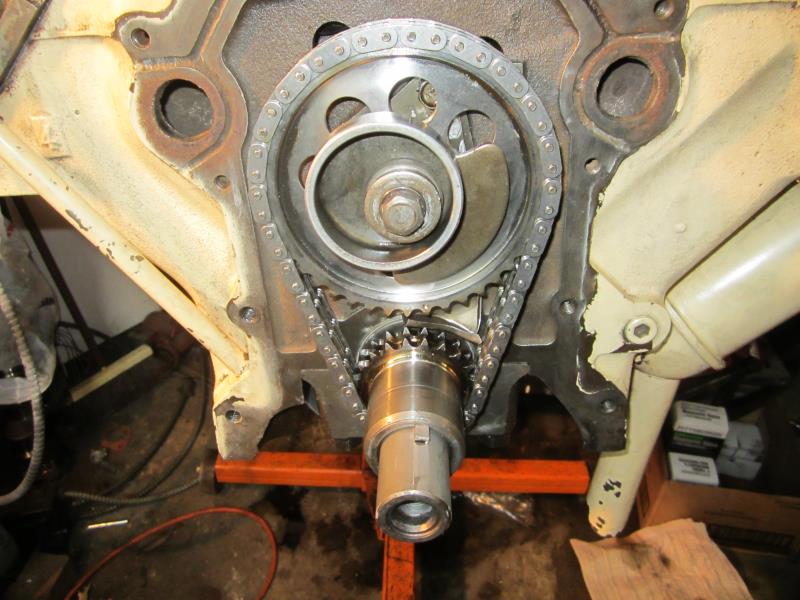
|
|
By Joe D - 6 Years Ago
|
Thanks for the info and the photo! Very helpful!
It's always hard to start when it's cold. Restarts when its warm or hot by just tapping key. I have been driving to work the last 2 days. Hard to start in the morning and afternoon when I'm leaving work.
Now I'm thinking its carburetion because last night I installed a fuel line pressure gage and this morning it took awhile to start. After cranking for about 10 seconds I checked the gage and it was holding 5.5 psi. I thought it was the fuel pump lever/ eccentric washer because it gave me a problem a few weeks ago. The electric choke was working fine until this morning. It did not fast idle around 1100 rpm like it did previously. I will check choke this afternoon and see why.
Thanks for your help!
|
|
By Ted - 6 Years Ago
|
You can rule out the fuel pump arm not being on the cam mounted eccentric as that would prove to be a problem all the time and not just when trying to start the engine.
Assuming the carburetor bowl or bowls are not draining down due a blown power valve or other leakage, then for a fresh morning startup I will depress the accelerator pedal two or three full times. Then wait ten seconds before attempting to start the engine as this gives the gasoline time to pre-vaporize before turning the engine over. I have an engine here with a supercharger on it and it requires no less than seven pumps of fuel for it to start effortlessly so you may have to experiment with the number of pre-pumps of gas before attempting to start the engine. If the choke is not working properly, then you may be required to ‘feather’ the throttle until the engine gets some heat into it.
|
|
By Joe D - 6 Years Ago
|
Thanks Ted!
I just adjusted the choke. The choke plate was not closed. The linkage seemed to be hung up a little bit maybe due to throttle linkage hitting it. She fired right up after the choke was adjusted. I will try the pre pump and wait 10 seconds method.
Thanks again, this site is a great resource for info, especially for a novice like me.
Hey, what is a power valve anyway and what symptoms would I notice with a blown one?
|
|
By charliemccraney - 6 Years Ago
|
Your Edelbrock doesn't have a power valve but it does have metering rods and springs which provide a similar function. They are a means of adding additional fuel under high load or high power conditions.
With a Holley, which has a power valve, symptoms would be idle adjustment screws which don't seem to do anything, rich smelling exhaust, possibly fowling plugs, draining fuel bowls, as Ted said.
On an Edelbrock, I think that the failure mode would be simply that you don't have the power function because about the only thing that can fail is the spring and I've not yet heard of that happening. So that would mean lean under high load or wide open throttle.
You can download the owner's manual for your carburetor from Edelbrock's website. It is a must read, one of the best. It goes over theory in the first part and while it's specific to Edelbrock, it applies to any carburetor so long as you understand which components effectively perform the same functions.
|
|
By Joe D - 6 Years Ago
|
|
Thanks Charlie, you da man!
|
|
By Joe D - 6 Years Ago
|
OK Y guys, truck is running good but I think it can run even better.
Idle timing is set at 9 BTDC. I had retarded this from 19.
How would I check total timing and what would be a ball park number since all engines are a little different?
Thanks for your help,
|